After finishing the Championnat National season in third place, Villefranche Beaujolais will face Quevilly in the French Ligue 2 promotion/relegation two-legged playoff. Winning their last five fixtures under French-Italian manager Hervé Della Maggiore, Villefranche Beaujolais moved into and retained third place giving the club the opportunity to play second-tier football next season for just the second time in their history.
With a month of consecutive losses after the winter break, Villefranche Beaujolais recovered in their 3-5-2 formation, having the most touches in the penalty area in the Championnat National whilst conceding the second-fewest goals. In this tactical analysis in the form of a team scout report, we will discuss Hervé Della Maggiore’s tactics that have brought Villefranche Beaujolais within two games of their first Ligue 2 return since 1983-84.
Villefranche Beaujolais build-up
Hervé Della Maggiore’s team tend to build up with short goal kicks to the three centre backs in the defensive third, as the wing-backs advance into the opposition half. With the opposition average PPDA against Villefranche Beaujolais being 11.36, the centre backs are often given space to carry the ball towards the halfway line. However, even when under pressure the centre backs have the confidence and technical ability to occasionally beat the first line of opposition pressure, before spreading play into wide areas.
Although the centre backs have good passing range, they usually play short passes in the defensive third. These passes find the two outside central midfielders, who dropped wide into the wing-back position, allowing the wing back to advance towards the final third. The two central midfielders are Florent Da Silva and Timothée Taufflieb. Da Silva, a loanee from affiliate club and Rhône-Alpes neighbour Olympique Lyonnais, has impressive ball manipulation and flair in abundance, ranking 15th for fouls suffered per 90 out of 74 central midfielders to have played at least 600 minutes in the Championnat National this season.
However, in these deeper positions, his flair and risky passes infield have resulted in turnovers, with Taufflieb being a comparatively safer option in such situations. Receiving in this area, the midfielders can progress up the wing with the wing-back, or by playing inside to the deepest midfielder, Rémi Sergio.
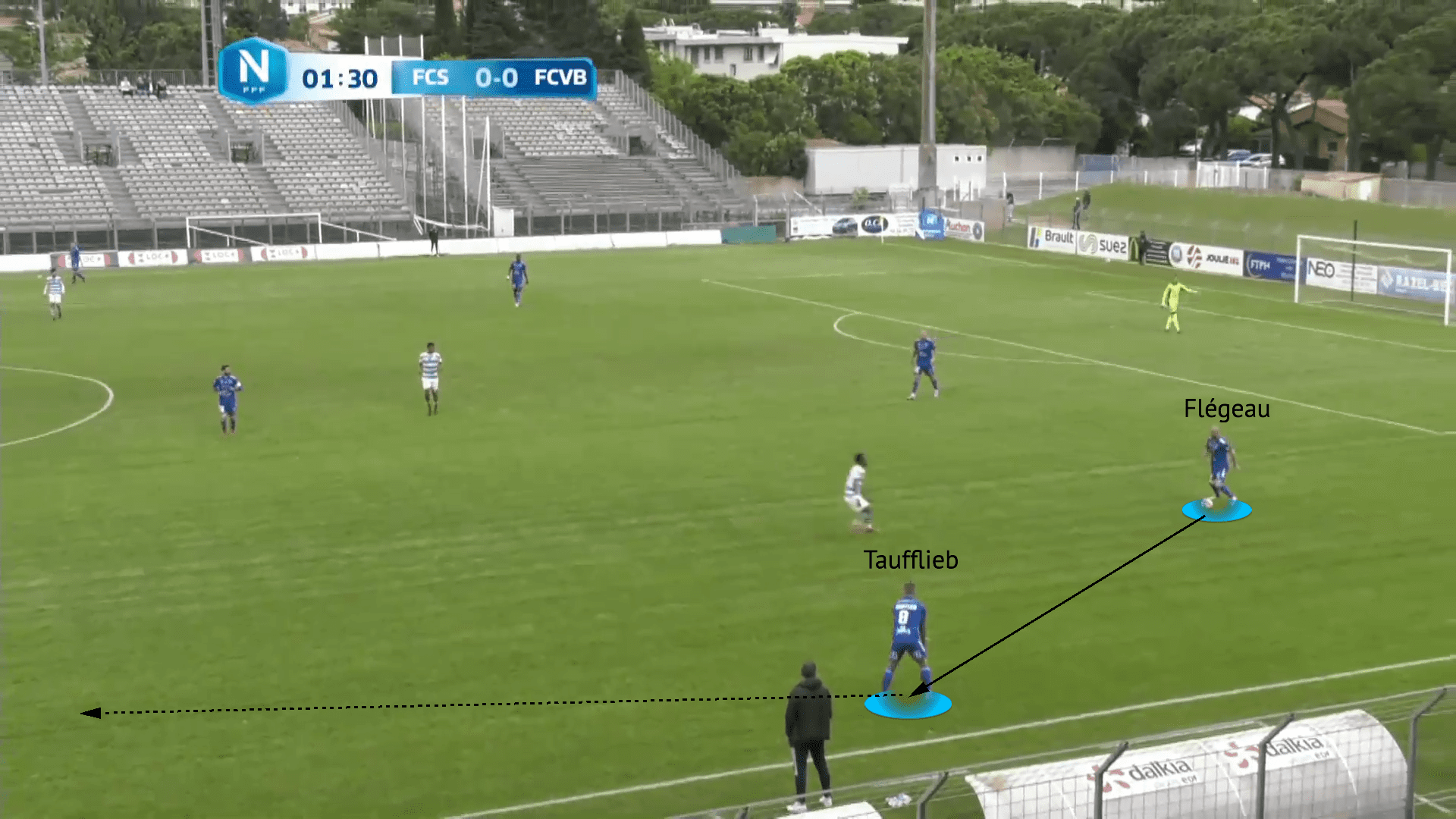
This figure shows an example of Taufflieb dropping from central midfield into the left wing-back position, receiving a short pass from left centre back Nicolas Flégeau. Taufflieb hasn’t been followed by an opposition midfielder, giving him the space to receive away from the closing Sète striker with the freedom to turn.
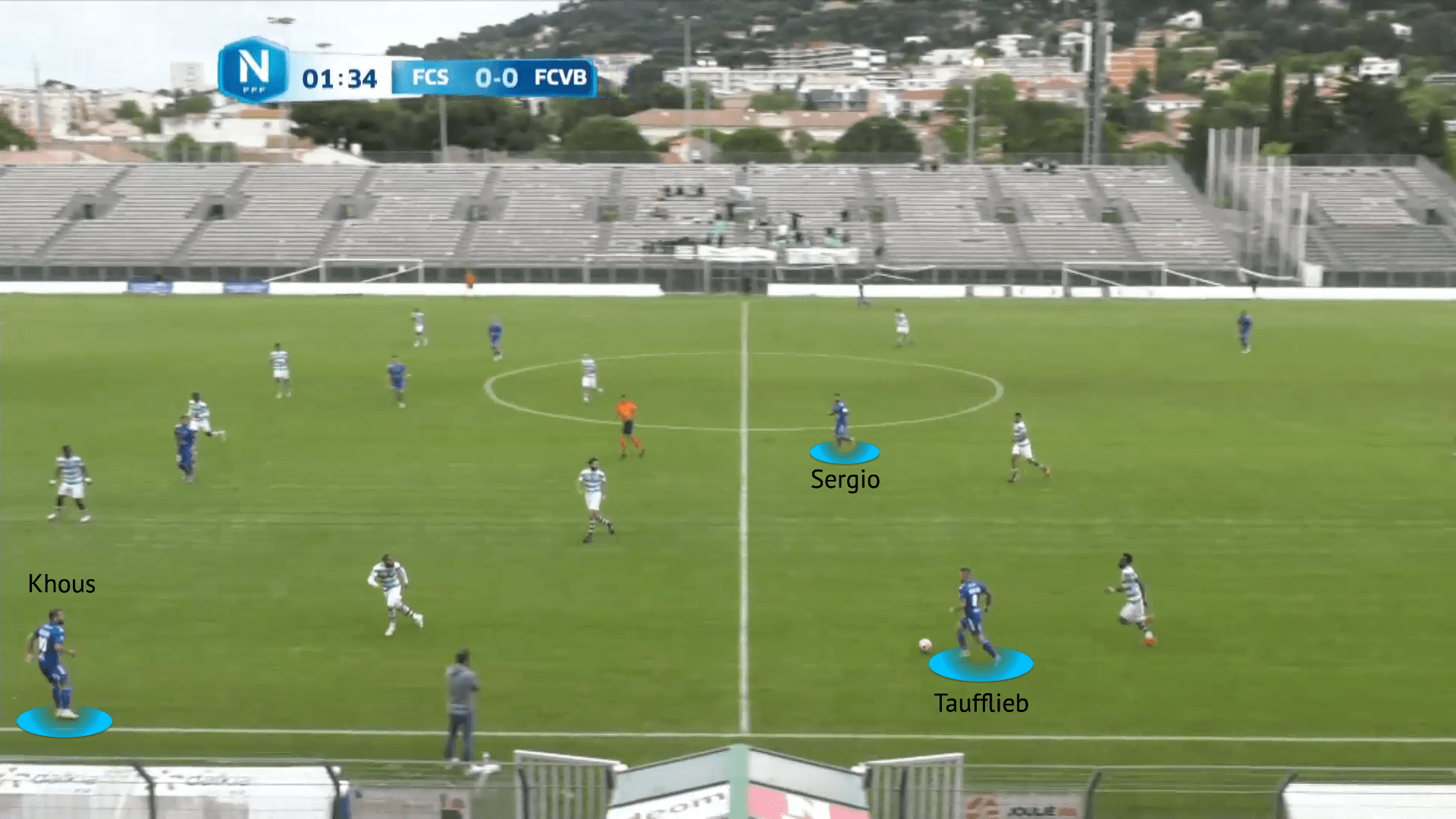
This figure shows left wing-back Guillaume Khous in an advanced position in the forward line, creating the space for Taufflieb to receive off the centre backs. Taufflieb has carried the ball forwards since ball reception and has passing options in left wing-back Khous, the ball-side striker, and Rémi Sergio in midfield.
Up-back-through combinations
Following on from their build-up, Villefranche Beaujolais utilise their wide overloads for up-back-through combinations, similarly to teams like Liverpool, Manchester City or even Marcelo Bielsa’s Leeds United. This tactic is commonly used with their wing-back and ball-side central midfielder and striker to break beyond the opposition’s defensive line. The striker drops, with his marker following, creating space for a pass in behind after the striker has set the ball back. A third man then exploits this space in behind, usually from the player that made the ‘up’ pass or potentially a different attacking runner. Taufflieb, the midfield shuttler, is pivotal to Villefranche Beaujolais’ up-back-through combinations.
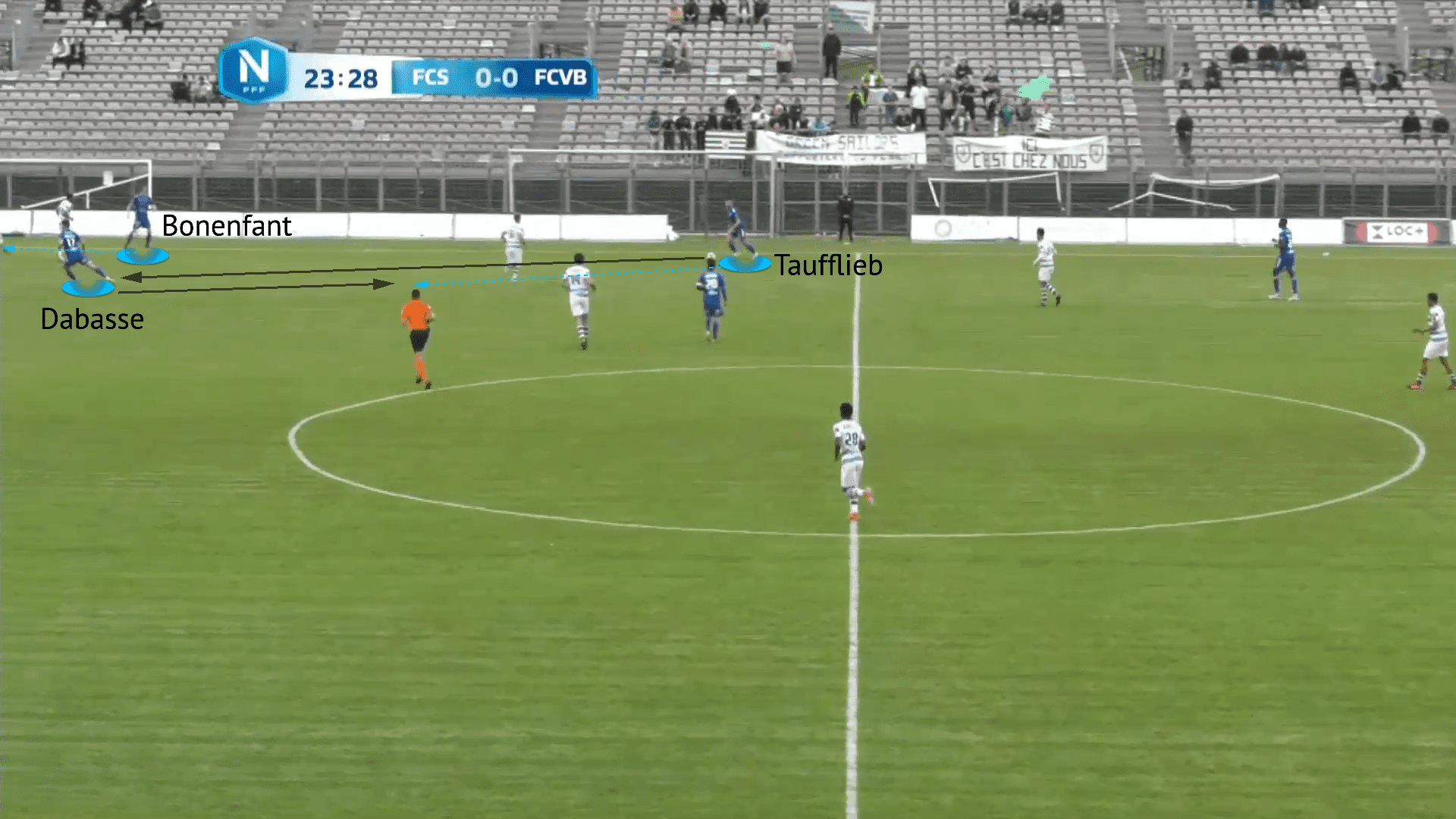
In this example, Taufflieb is in possession with striker Adrian Dabasse and right wing-back Rémi Bonenfant ahead of him in the right channel. Dabasse has made an effective double movement, creating separation to receive whilst simultaneously perturbing the opposition’s defensive line. This perturbation has created space for Bonenfant to exploit.
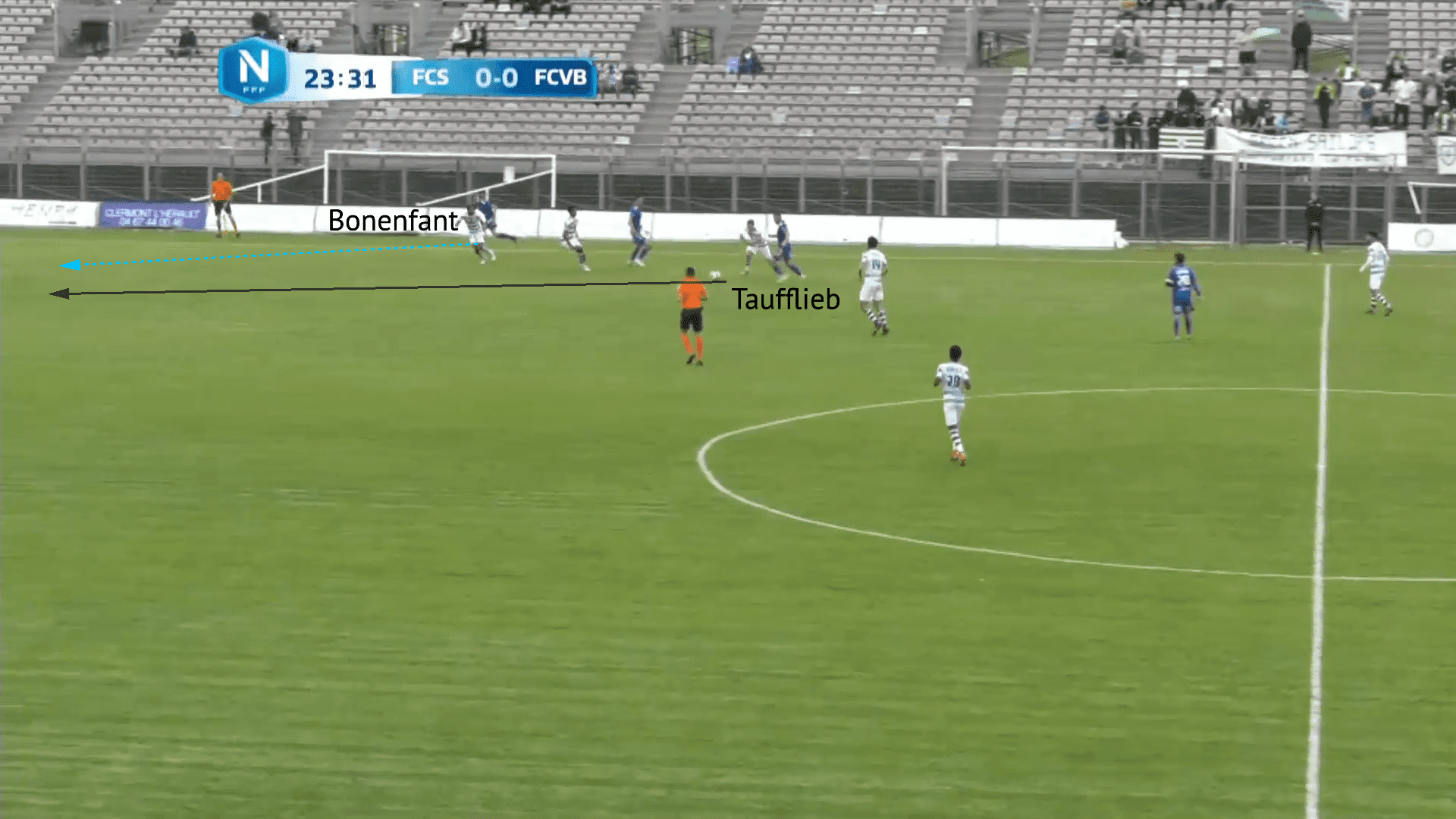
Here, Taufflieb has followed his pass whilst Dabasse played the setback pass, allowing him to release Bonenfant with a first-time ball. As Bonenfant is aware of Villefranche Beaujolais’ up-back-through combinations and Taufflieb’s intentions in possession, he has dynamic superiority over the opposition marker. This allows him to power ahead of the opponent with his blindside run to penetrate the defensive line.
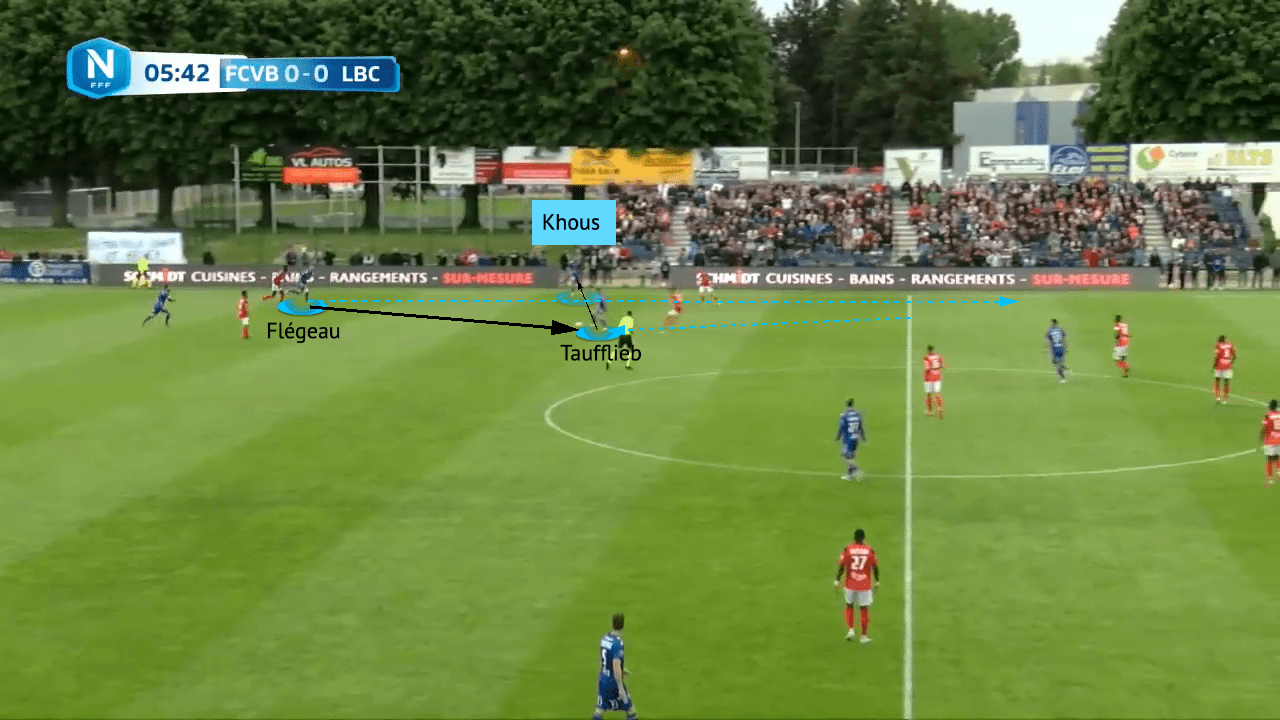
This figure shows an attempted left-sided up-back-through combination against Chateauroux, from a deeper position, involving the centre back Flégeau rather than a striker. However, Taufflieb’s run from the forward line imitates a striker’s movement and in turn created space in the opposition defensive unit. The player to attack this space is Flégeau, who continues his run after his pass into Taufflieb, aiming to receive a pass into the space from left wing-back Khous. The pass was blocked, resulting in a Villefranche Beaujolais throw in, but still shows their variations of creating up-back-through combination opportunities.
Attacking set-pieces
Alongside being club captain, diminutive midfielder Rémi Sergio’s responsibilities also cover set-pieces as the primary corner and free-kick taker for Villefranche Beaujolais. Setting up with two players on the edge of the box and five players located around the penalty spot, Sergio’s corners are delivered towards the near post, with usually two players darting to the front zone. Villefranche Beaujolais rank in the top five in the Championnat National for shots from corner kicks, however, their threat remains as defenders stay in the final third to attack second phase crosses.
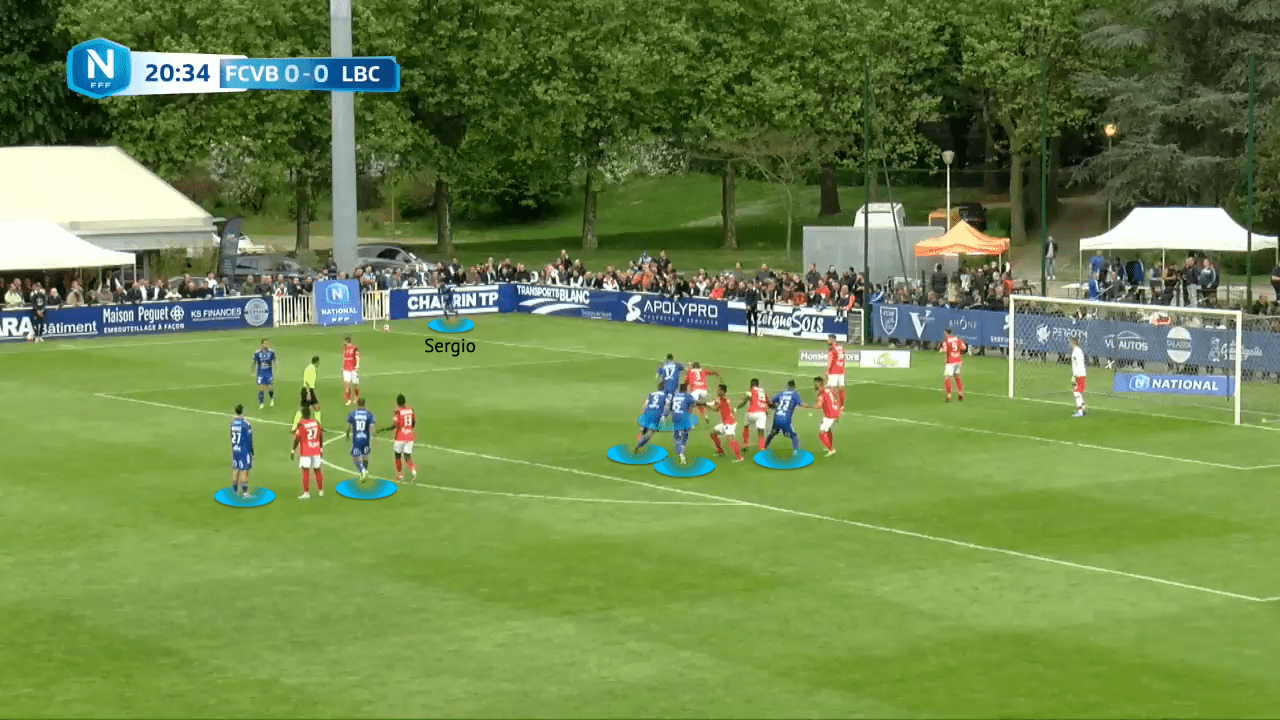
This figure shows four Villefranche Beaujolais players active in the opposition box, the other player returning from an ignored short corner attempt, with two players on the edge of the box. The figure below shows the second phase threat from the same corner kick resulting in an attempt at goal, with Da Silva, Dabasse and striker Simon Elisor being joined in the box by Bonenfant and centre back Malcom Bokele.
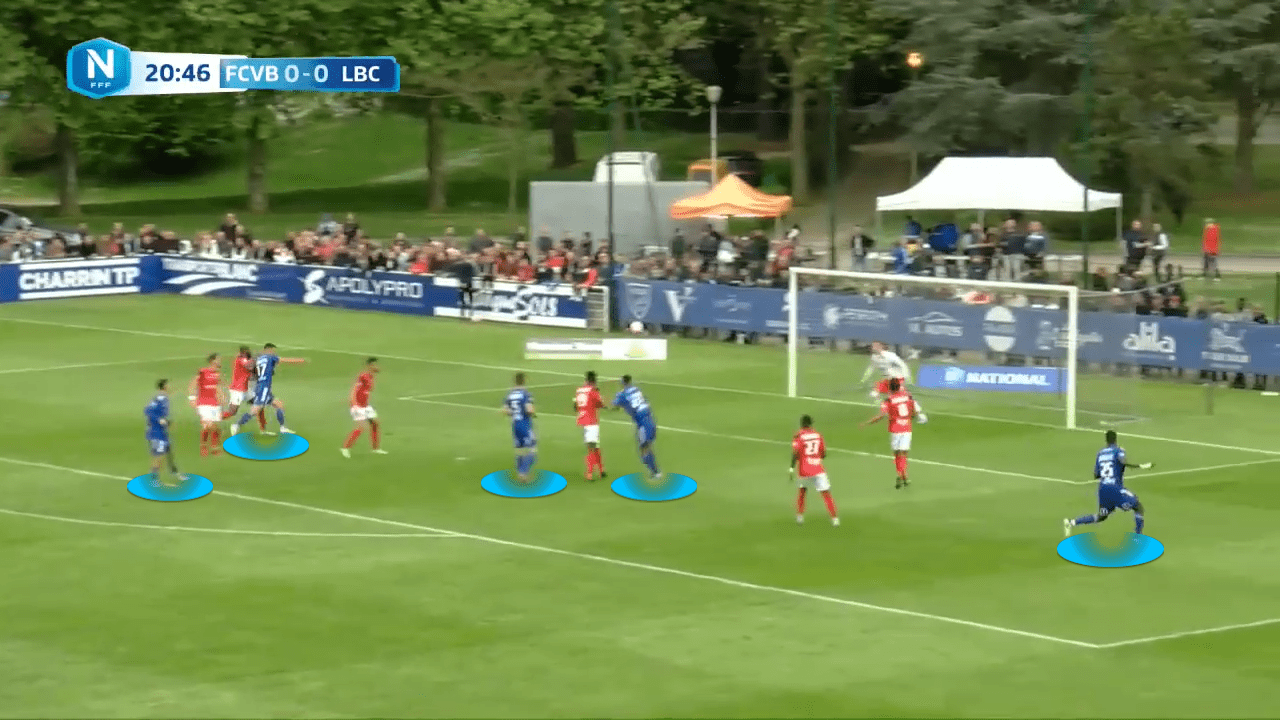
Sergio’s left and right corner kicks are often delivered to the near post. However, there is some variety. When Villefranche Beaujolais have struggled from corners in a game, they will attempt to play short to create a different crossing angle. In recent games, short corners have provided Villefranche Beaujolais with the opportunity to deliver crosses from deep towards the penalty spot or with pace across the six-yard box from the byline. Sergio also looks to create crossing angles from attacking free-kicks in central areas by passing into wide areas and half-spaces. From the free-kick pass, these angles from wide allow Villefranche Beaujolais to deliver the ball towards their centre-back targets in the box, who also threaten from corner kicks.
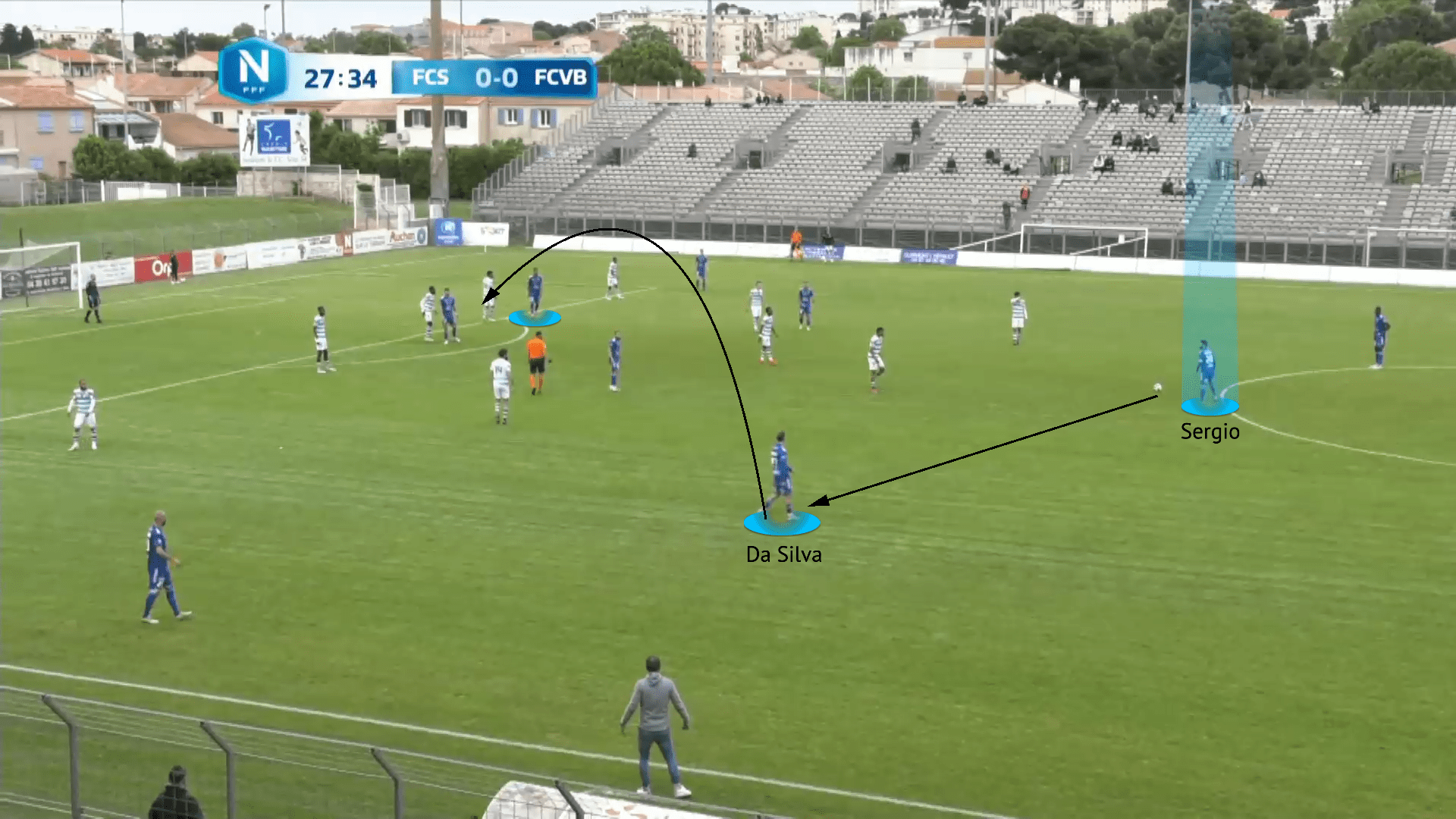
This figure is an example of Rémi Sergio changing the angle of the delivery into the box by passing to Florent Da Silva in the left half-space.
Villefranche Beaujolais out of possession
Out of possession, Villefranche Beaujolais naturally shape up in a 5-3-2 formation when the opposition advance past the halfway line. When their opponents have possession in their own defensive third, Hervé Della Maggiore’s team rarely press with much coordination and teamwork. Often, one of the strikers will close down the ball carrier, but support from behind to cut passing options will be delayed. This leads to a more reactive press to the opposition’s actions, rather than pressing and attempting to dictate the opposition’s first build-up phase. However, Villefranche Beaujolais’ set-up beyond this is proactive, leading to their 8.82 PPDA. In comparison, the average PPDA in the Championnat National this season is 10.47.
This proactivity springs with the midfield line closing the space towards the forwards, with the three centre backs aggressively man-marking opposition forwards. As the opposition usually line up with a two striker formation against Villefranche Beaujolais, they have a 3vs2 overload with a free centre back providing cover and balance. However, the combination of a higher midfield line and a man-marking defence leads to enlarged space between the lines.
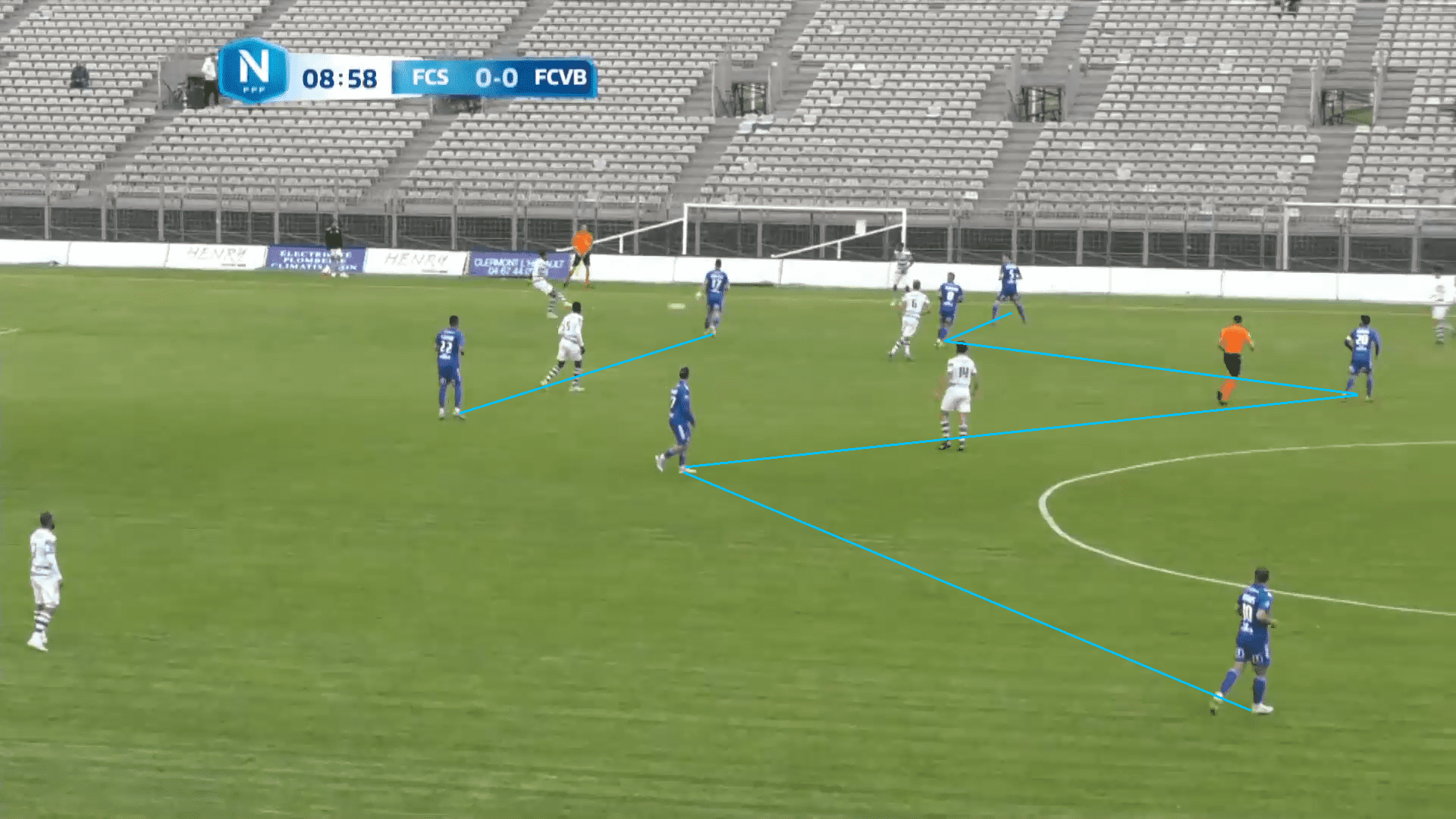
This figure shows Dabasse moving wide to close down, but support is provided due to Villefranche Beaujolais’ method of defending in wide areas which will be discussed in a moment. The figure shows the advanced midfield line, creating space between the midfield and defensive line which will be shown in the next figure.
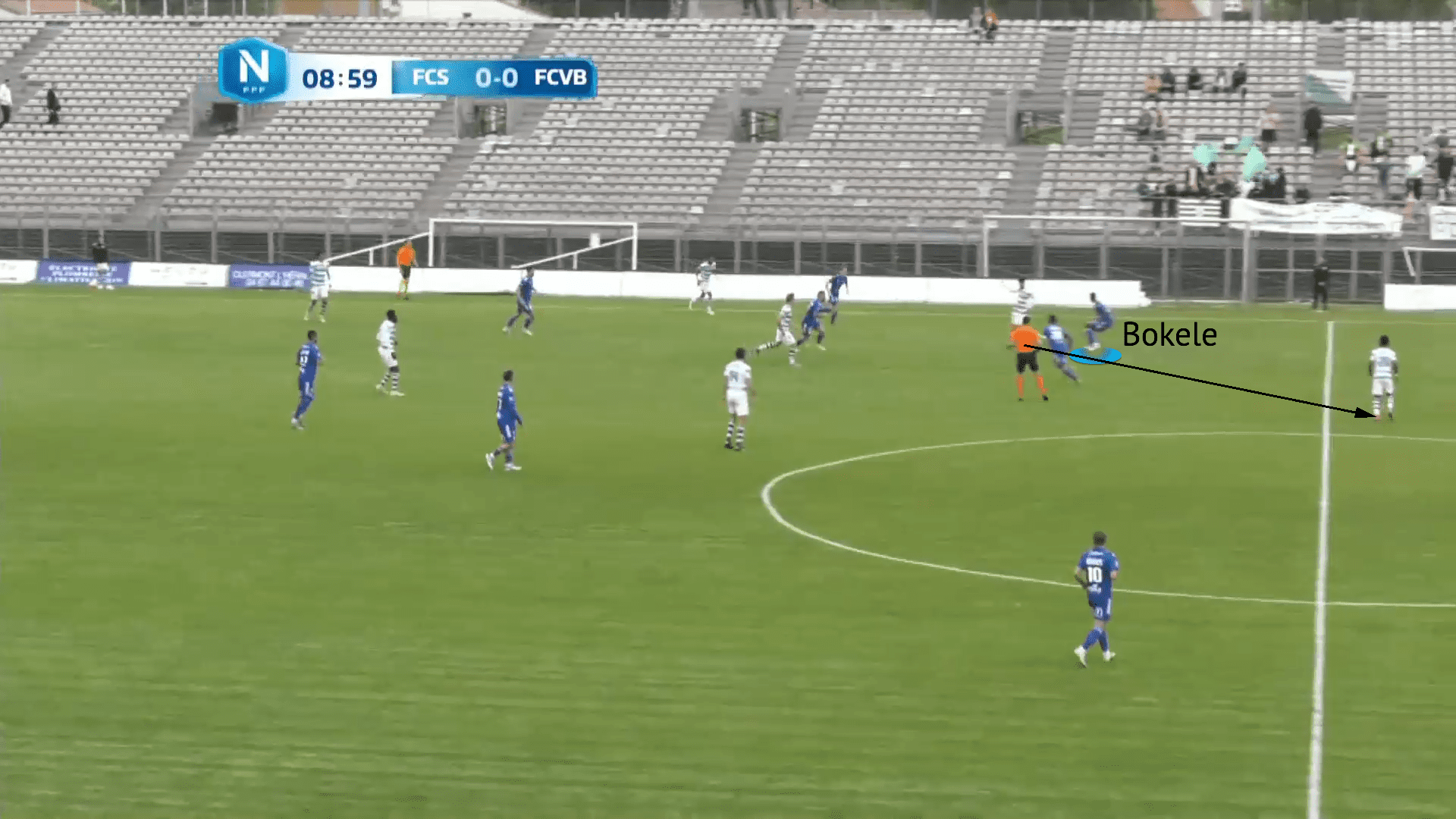
The Sete defender has executed a line-breaking pass into the striker, who has been followed by man-marking right centre back Malcom Bokele. Despite being tasked with man-marking the striker, Bokele is unable to engage and cannot prevent the pass into the free man between the lines.
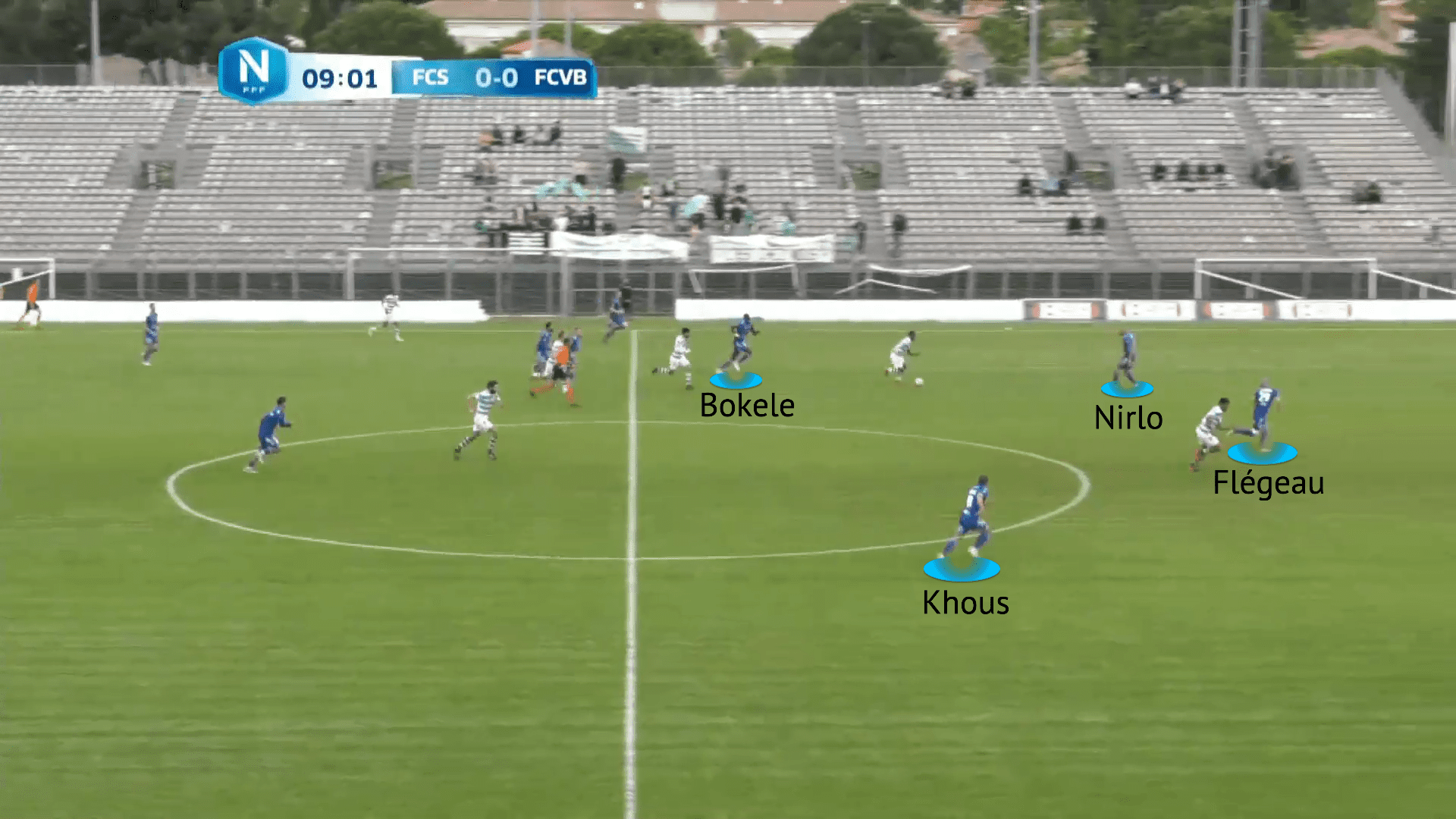
Here, we can see the issue created for Villefranche Beaujolais by the advanced midfield line and dysfunctional man-marking, leaving the Sete attacking midfielder unpressured. Receiving in space between the lines, Sete are able to turn and drive at pace at an exposed defence with a 2vs2 situation. From this situation, the attacking midfielder threaded a pass into the striker’s run, who was able to cut inside between Flégeau and Khous. After cutting inside, the striker played a return pass to the attacking midfielder, creating a clear goal-scoring opportunity of 0.44 xG but was poorly finished and saved by Lucas Caruso.
Defending in wide areas
In wide areas, Villefranche Beaujolais look to create an overload to deny and delay opposition progression, attempting to dictate play backwards. They overload with ball-side wing-back and central midfielder, with further support from the outside centre back, Rémi Sergio, and the ball-side striker tracking back to press from behind. When the opposition tries to play up the wing, the ball-side wing-back will push up with the midfield. This leads to the opposite wing-back dropping alongside the three centre backs.
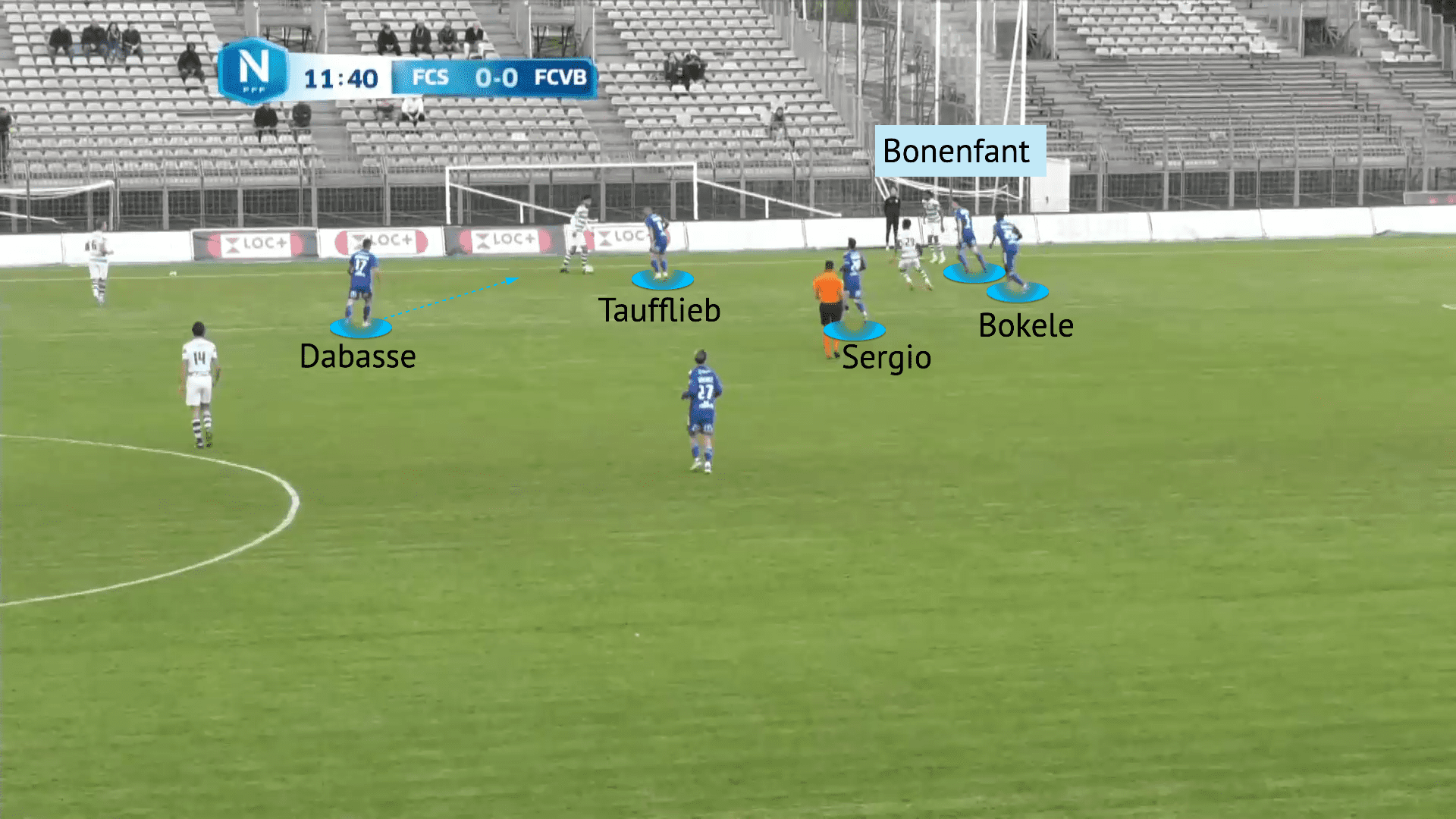
This is a right-sided example of Villefranche Beaujolais creating an overload in wide areas. Taufflieb provides pressure as the ball-side central midfielder with ball-side striker Adrian Dabasse closing from behind. Rémi Sergio supports infield as the defensive midfielder with Rémi Bonenfant and Malcom Bokele picking up Sete’s forward passing options. Florent Da Silva has also narrowed to keep a more compact midfield.
As shown above, when the opposition move players from central areas to the wings, the ball-side central midfielder will go out to press. In the above example, Timothée Taufflieb is the ball-side central midfielder. Due to this instruction, technically gifted Florent Da Silva must also fulfil these pressing duties in the wide areas. As a creative midfielder who has a prominent influence on his team when in possession, Da Silva gets involved defensively and presses wide areas with great effect. Villefranche Beaujolais’ January loan signing from Olympique Lyon has completed 8.68 successful defensive actions per 90 in the Championnat National since joining.
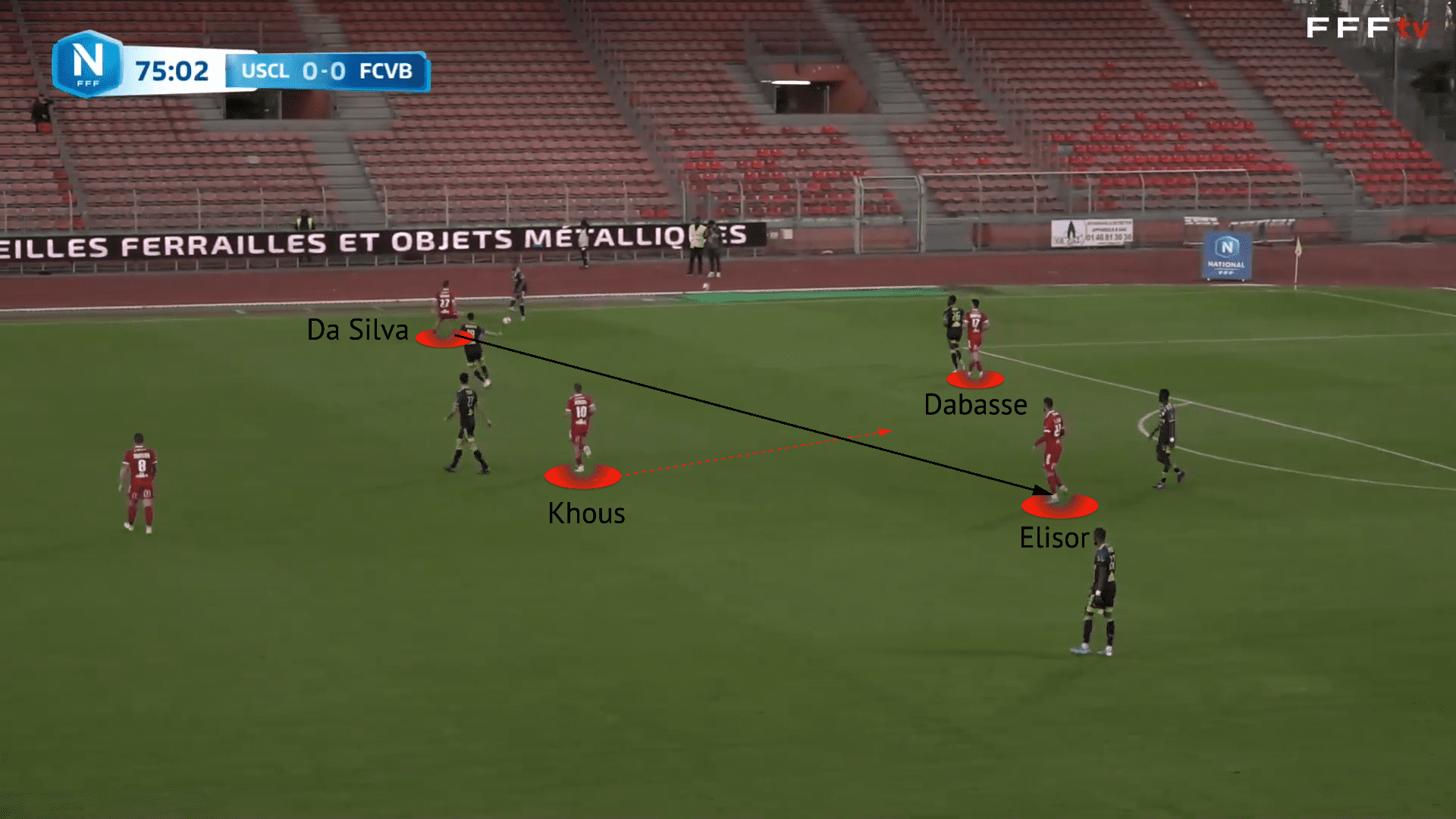
This figure shows Da Silva going wide to press the Creteil right back. Da Silva cuts the passing lane inside to the midfielder and intercepts the attempted pass. Managing to shift the ball inside, Da Silva tries to find Khous’ run but the ball runs through to Simon Elisor, who dispatched the ball into the bottom left corner effortlessly.
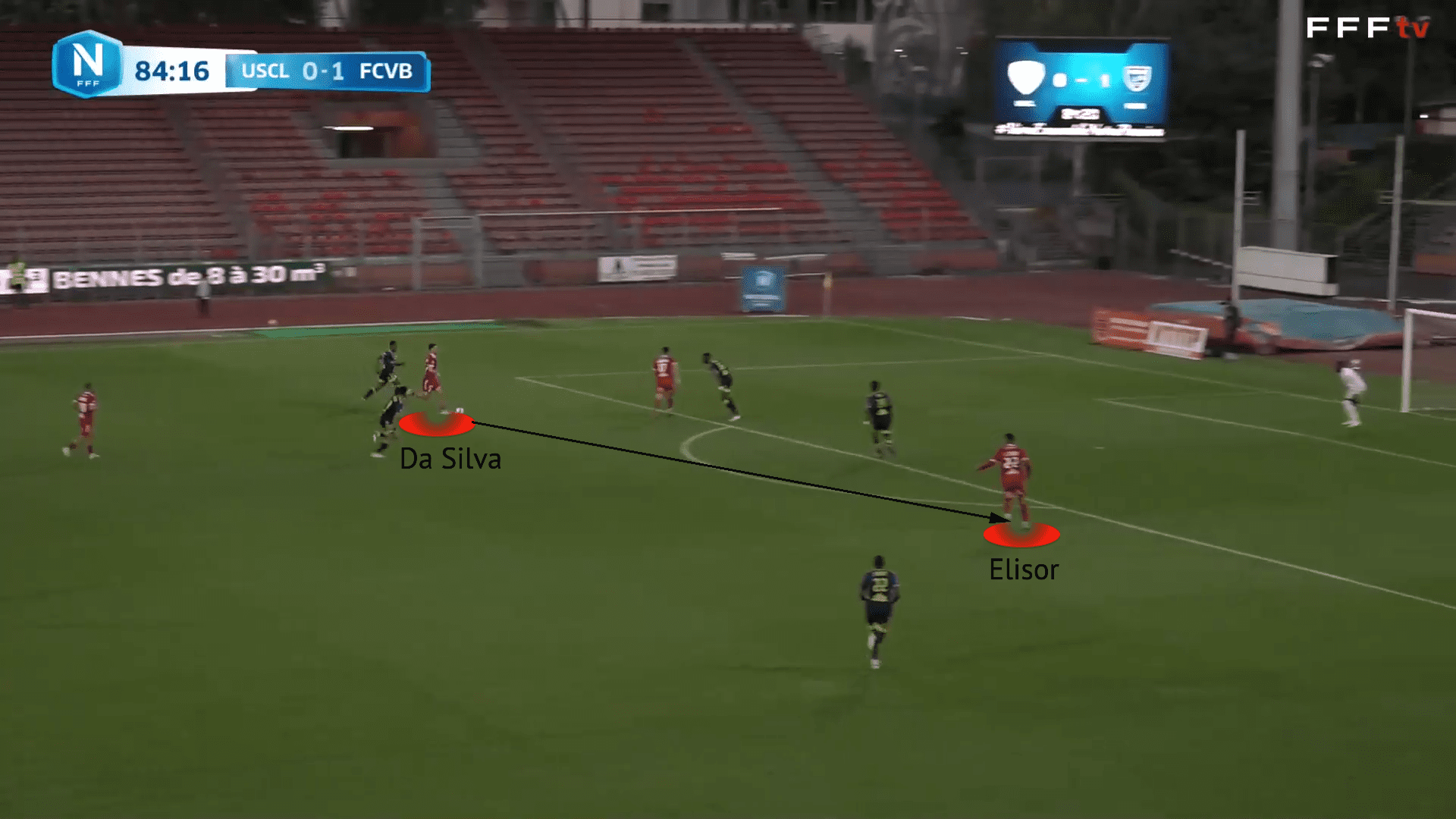
This is an example later in the same game, with Florent Da Silva intercepting a pass towards the right back from the Creteil goalkeeper. Da Silva drives with the ball to the penalty box, before assisting Elisor with an almost identical goal to double Villefranche Beaujolais’ lead.
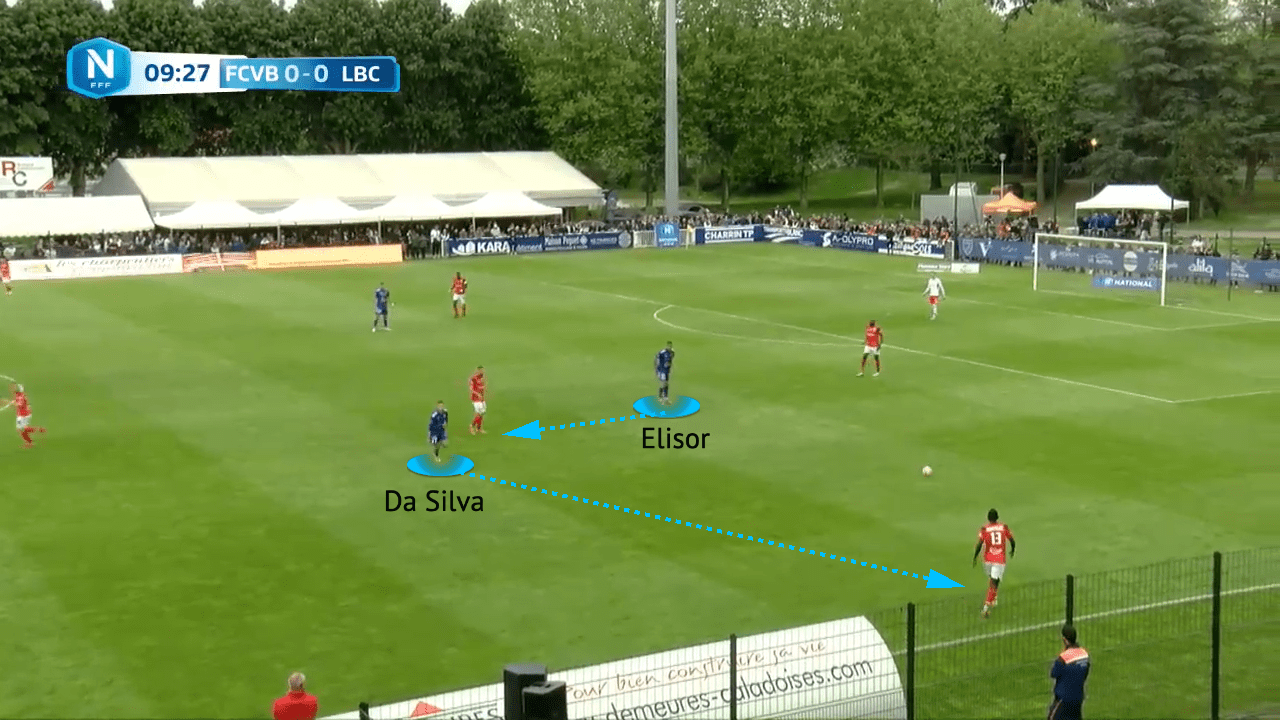
With the ball-side central midfielder pressing out wide, in this instance Florent Da Silva, Villefranche Beaujolais still wants to prevent opposition central progression. Positioned between the Chateauroux defender and central midfielder, Elisor has blocked the passing lane and forced the ball wide. This is Da Silva’s trigger to press the receiving defender out wide. As Da Silva presses wide, Elisor drops into the midfield line, able to intercept a pass inside whilst still being able to close down a backwards pass to the centre back. With Elisor recognising Da Silva’s movement to press, he maintains Villefranche Beaujolais’ three-man central midfield structure.
Defending set-pieces
Villefranche Beaujolais enforce a rule of having two more outfield players in the box than the opposition when defending corner kicks. They man-mark opposition in their penalty box, in addition to one player occupying the front zone and another occupying the middle zone to follow the +2 rule. This rule can lead to situations where Villefranche Beaujolais go 9-vs-7 in the box, or as few as 6-vs-4. Usually, one player will be on the edge of the box with one remaining up top, however when the opposition commits greater than seven players into the box the most advanced player would drop to the edge of the box. Villefranche Beaujolais’ preference to have their ten outfielders in the defensive third hinders their counter-attacking ability, whilst allowing the opposition to sustain pressure and ball possession from the second phase.
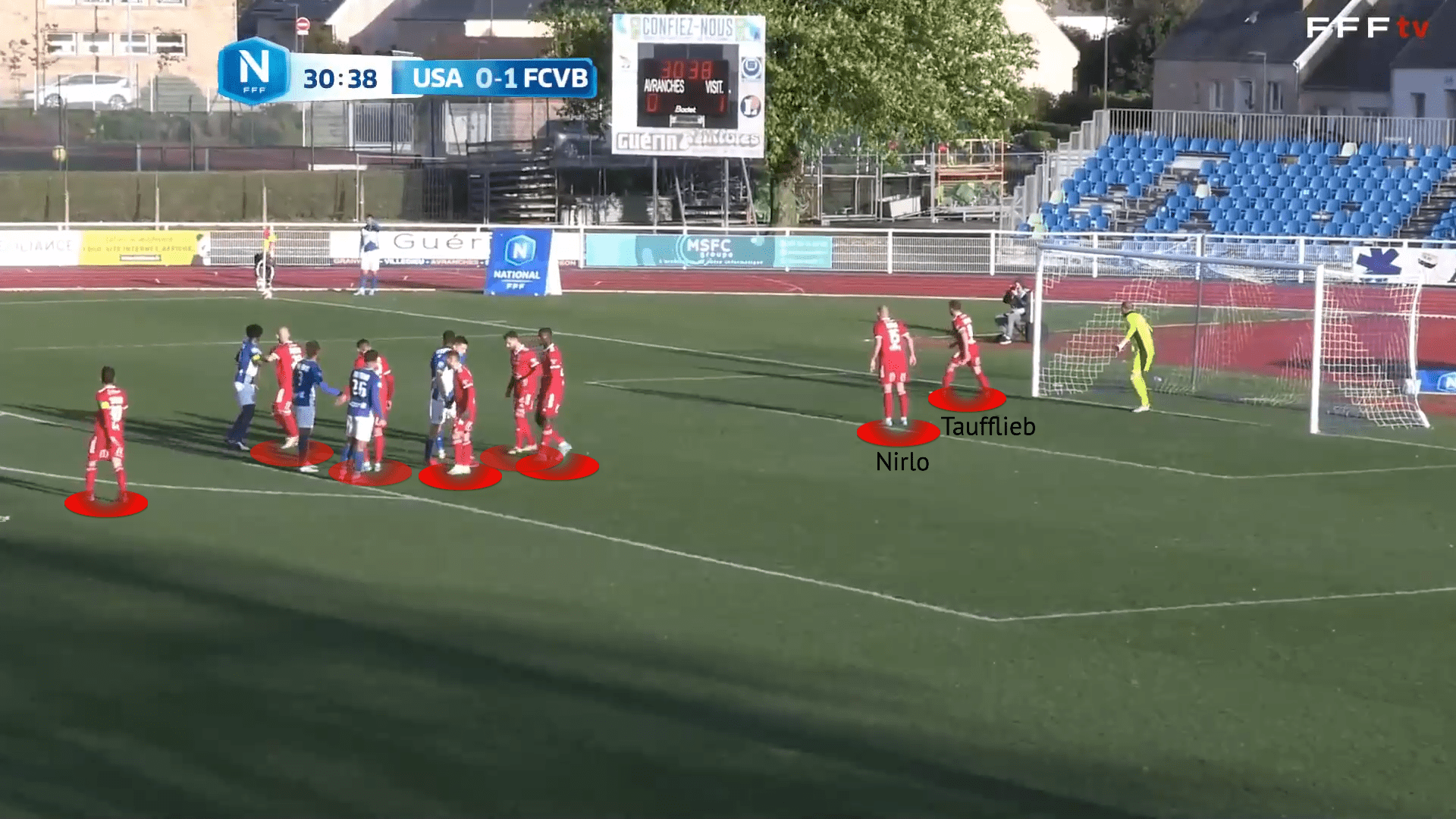
This figure shows the common Villefranche Beaujolais set-up when defending corners, with centre back Jimmy Nirlo occupying the middle zone and midfielder Timothée Taufflieb performing the role of the front zone player. Villefranche Beaujolais man-mark Avranches 5-vs-5, with Rémi Sergio and Florent Da Silva on the edge of the pitch.
The lack of marking responsibilities allows the front and middle zone players to attack the ball and fulfil their roles effectively, whilst covering areas ahead of the goalkeeper. This is crucial for Villefranche Beaujolais, as their goalkeepers Lucas Caruso and Jean-Christophe Bouet remain on their goal line when defending corners. However, this is an issue when the opposition gets first contact on near post deliveries, flicking the ball on towards the back post for a teammate to have a high-quality shooting opportunity.
Attacking transitions
After regaining possession in any area of the pitch, Villefranche Beaujolais will attempt to progress the ball towards the strikers as quickly as possible. This direct approach in transition has mixed accuracy and ball retention. Complete forward Simon Elisor is the common target in transitions, with midfielders looking to release him in behind immediately. This has led to Elisor recording the most offsides in the Championnat National this season with 40 offsides, 10 more than the second-highest. However, some Villefranche Beaujolais passes in transition can be poorly weighted and influenced by the opposition defensive line. This can lead to passes toward Elisor creating aerial duels. Elisor wins 42.13% of his aerial duels, ranking him 34th out of 123 strikers in the Championnat National.
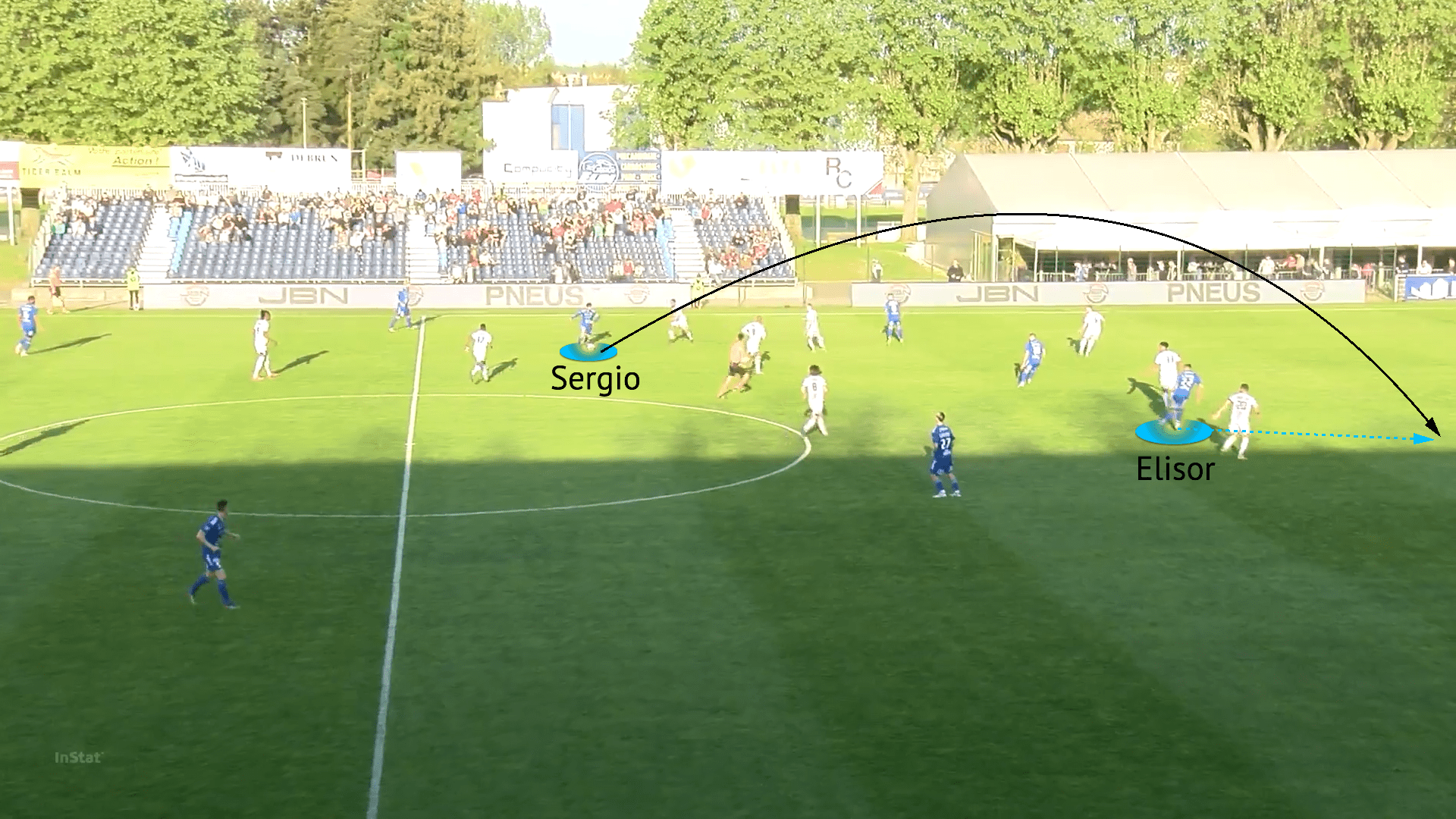
This is an example of midfielder Rémi Sergio regaining possession and looking to play Elisor in behind within five touches of the regain. As Sergio looks down to execute the pass, he triggers Elisor’s run in behind the defensive line.
Villefranche Beaujolais will look to construct an attack after regaining possession if there is an area to exploit, or if they have enough options and support ahead of the ball. Villefranche Beaujolais attempted to break with two players supporting their two strikers. These two supporting players are usually the two central midfielders or a wing-back with a midfielder. Midfielder Florent Da Silva is usually involved, with his on the ball quality and ability to recover second balls. In the example below, it is Da Silva’s cleverness to recognise and penetrate space to be exploited.
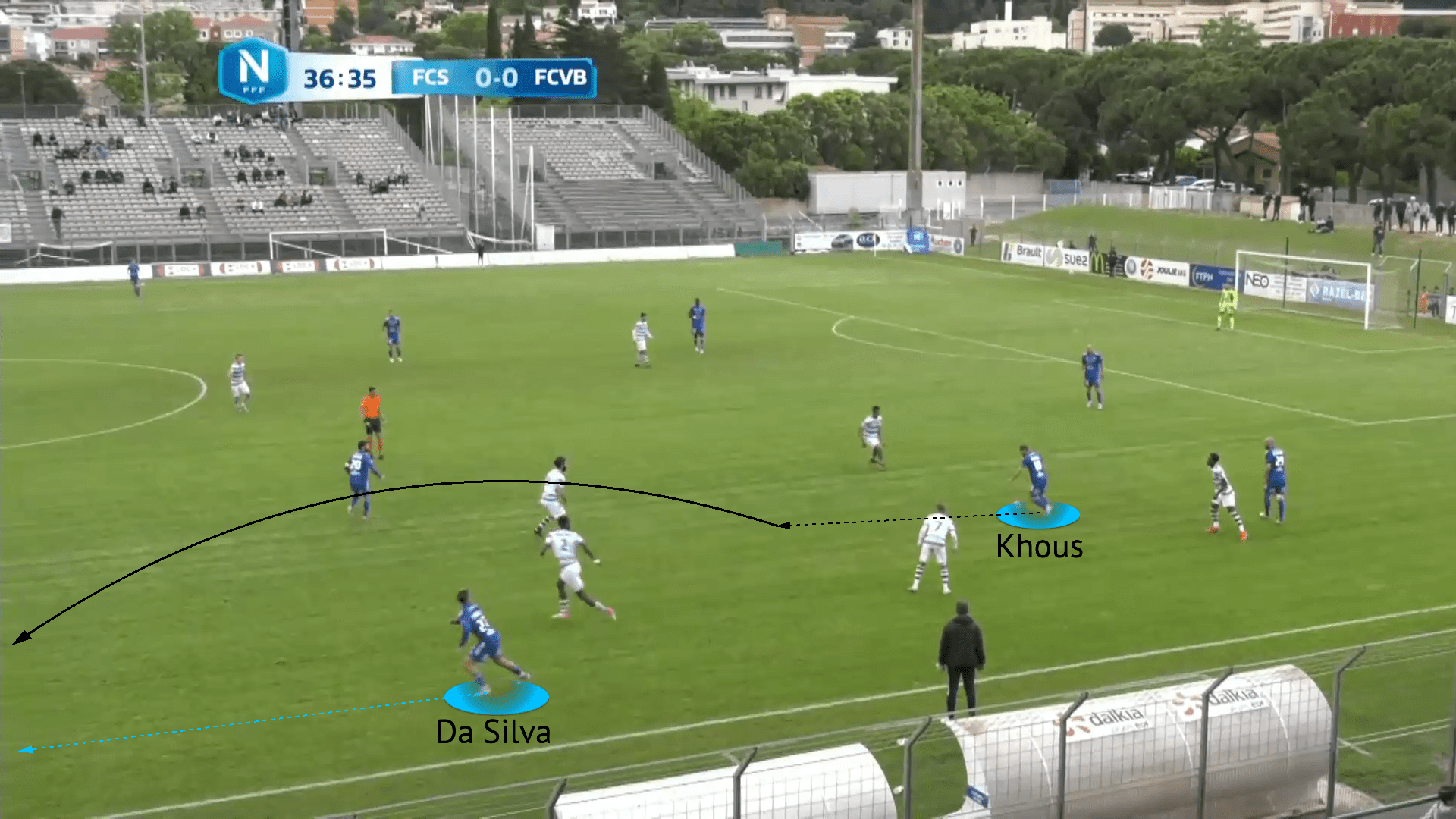
This example shows left wing-back Guillaume Khous controlling a flick from left centre back Nicolas Flégeau that regained possession. Khous’ line-breaking dribble gave time for Da Silva to spin and exploit the space behind the advanced Sete right centre back. As shown below, Khous’ pass in behind was kept in play by Da Silva, who released Dabasse with a nicely weighted outside of the foot pass.
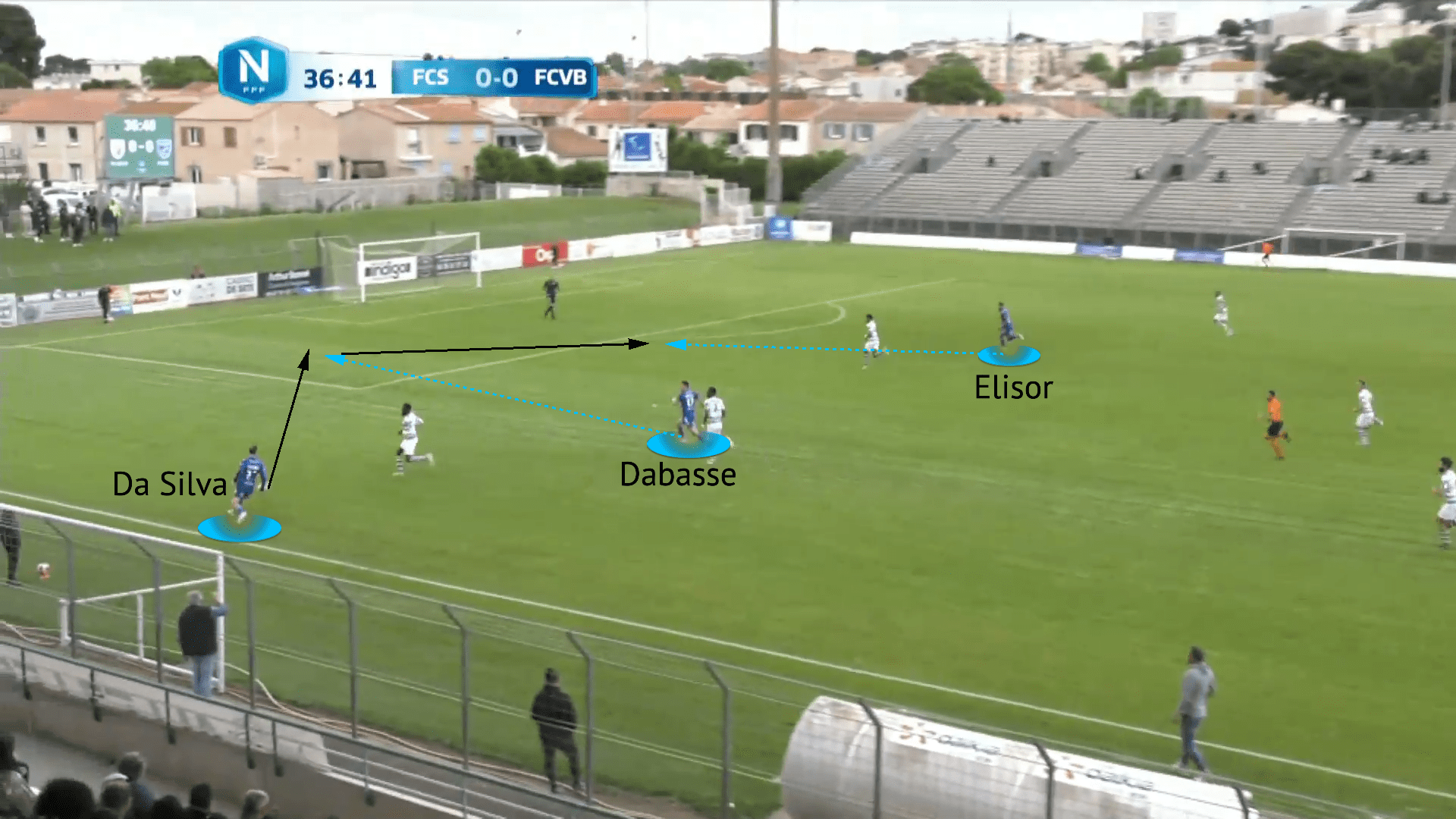
Defensive transitions
Defensive transitions are one of Villefranche Beaujolais’ weakest areas. With their attacking danger, especially in the final third, involving overloads and large numbers, there is always the possibility of Villefranche Beaujolais conceding chances via opposition counterattacks. Losing possession with a pass in behind, like the attacking transition situations above, triggers the nearest attacker to press the opposition defender who is chasing the pass, facing their own goal. These situations are usually the only defensive transition situation that brings an immediate reaction.
With Villefranche Beaujolais players preferring to attack and provide passing options ahead of the ball, they become frustrated after a promising attack gets shut down. Leaving the defence exposed, the midfielders are slow to make recovery runs and the wing-backs are in advanced positions. The right wing-back Rémi Bonenfant is the best reacting player, always quick to get back and deny opposition attacks, meanwhile the left wing-back Guillaume Khous’ attacking instincts notably outweigh his defensive abilities.
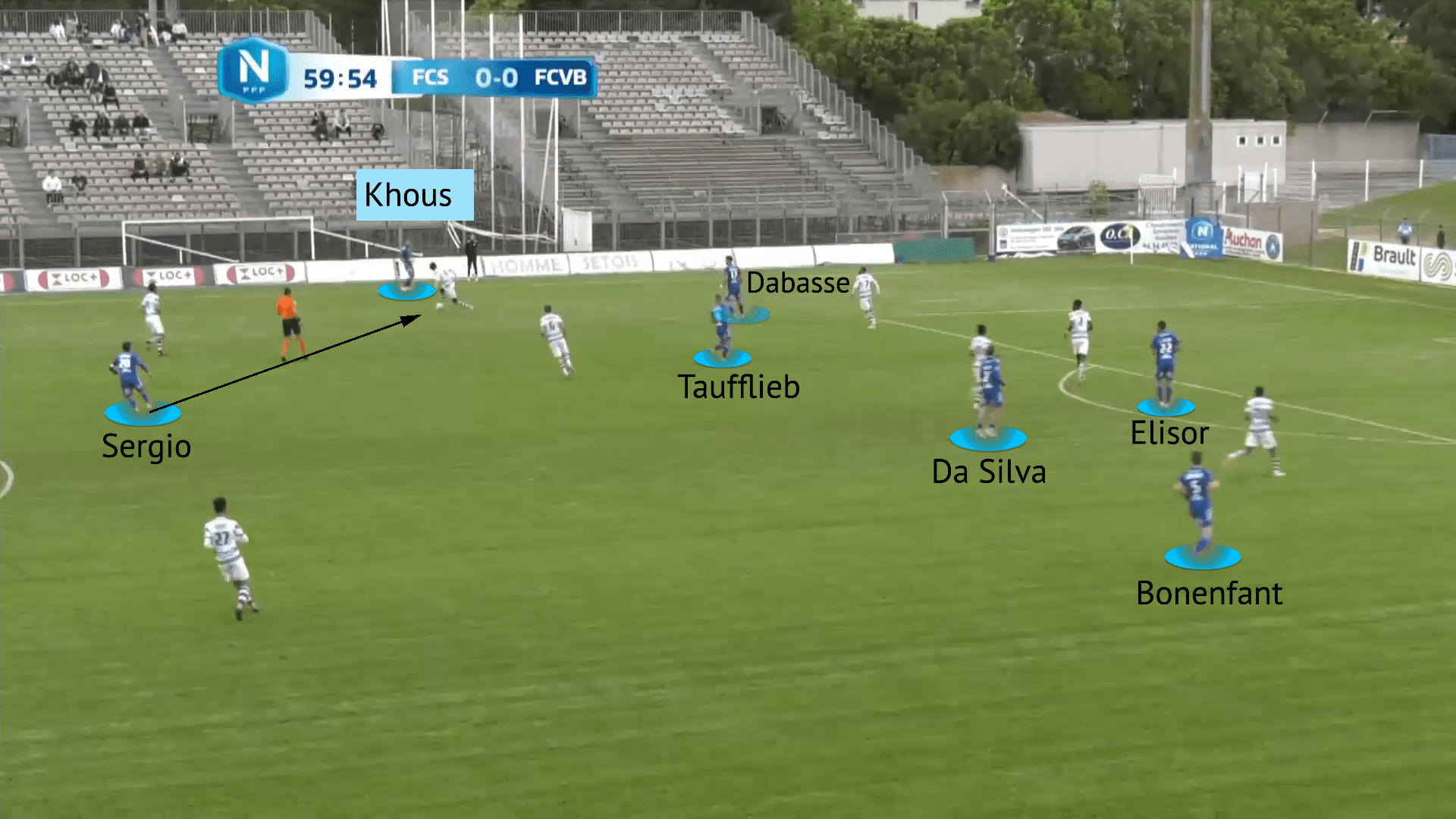
This figure shows Villefranche Beaujolais committing numbers forward, leaving them exposed after Rémi Sergio’s under-hit pass was intercepted by the Sete right wing-back. With a bad reaction to this transition, Villefranche Beaujolais will attempt to defend this counterattack without their left wing-back, two central midfielders, and two strikers. Right wing-back Rémi Bonenfant managed to get back into the defensive line later.
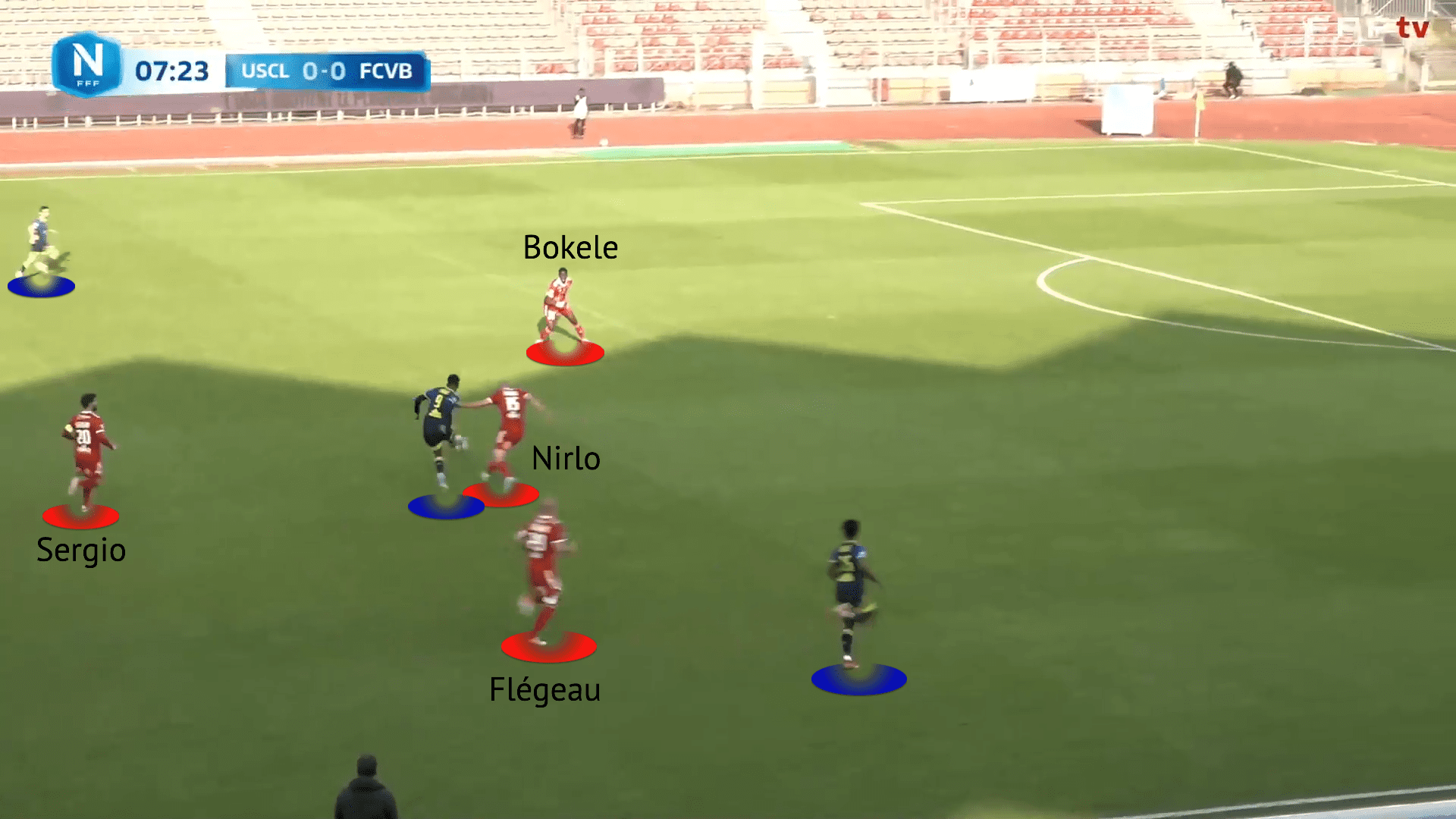
When Villefranche Beaujolais are struggling to break down their opposition in an attack, one of the three centre backs will step into the midfield to provide another option and further overload the opposition. Left centre back Nicolas Flégeau has fine technical abilities and can influence attacking play to a higher degree than Bokele and Nirlo due to the angles provided in the left half-space. Flégeau has completed 404 progressive passes in the Championnat National this season, more than any other player. This aggressive strategy of advancing Flégeau leaves centre backs Malcom Bokele and Jimmy Nirlo, and holding midfielder Rémi Sergio with little support in unfavourable situations.
The figure above is an example of a Creteil counterattack, where Creteil were able to find their striker between Nirlo and Sergio. Flégeau’s positioning in midfield has allowed Creteil’s right-winger to get in behind and goalside of the left-sided centre back. Right wing-back Rémi Bonenfant’s attacking position has left Creteil’s left-winger to exploit the space wide of Bokele.
Strengths
One of Villefranche Beaujolais’ biggest strengths is the ability of their two-man strike partnership of Simon Elisor and Adrian Dabasse. Elisor, on loan from recently promoted into Ligue 1 side Ajaccio, is one of the most complete forwards in the Championnat National. Scoring 17 goals from 10.36 xG, Elisor has the biggest xG overperformance in the league. With four goals coming from outside the penalty box, the joint-most in the league, he has goal-scoring variety. His ruthless nature with first-time finishes and quick shifting of the ball before shooting allows him to release shots unexpectedly for goalkeepers.
Adrian Dabasse, with five goals and five assists in the Championnat National this season, plays his part in the Villefranche Beaujolais frontline. Dropping into deeper areas and offering overloads out wide, Dabasse’s movement for ball progression allows Elisor to occupy and restrict opposition defences. Despite this movement, Dabasse consistently manages to get himself into dangerous areas with possession in the final third, having the most touches in the opposition box per 90 in the Championnat National with 5.91. The duo’s influence on this team goes beyond goal-scoring, with Elisor ranking third and Dabasse ranking sixth for total key passes.
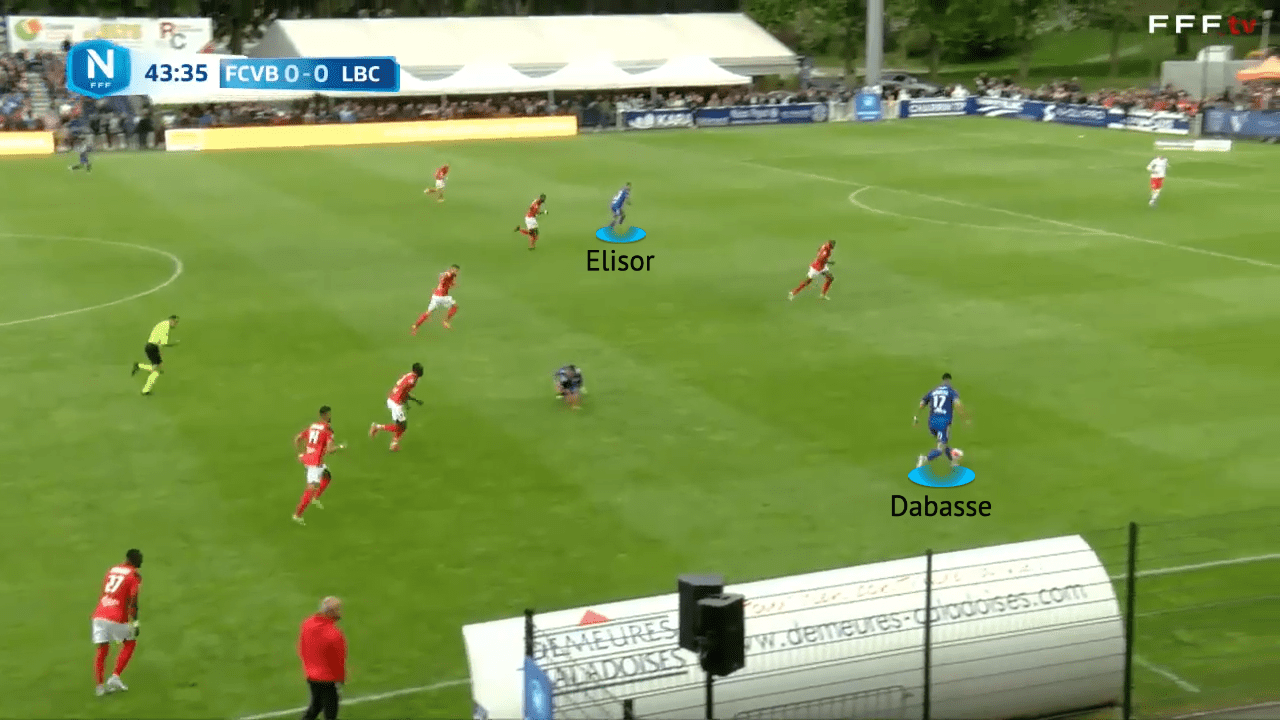
Above is an example of Adrian Dabasse drifting wide to receive a forward pass, bringing Villefranche Beaujolais up the pitch. Dabasse’s movement to receive means Simon Elisor can stay on the shoulder of the last defender, stretching the Chateauroux defensive line and forcing their defenders to make instant decisions to prevent penetration.
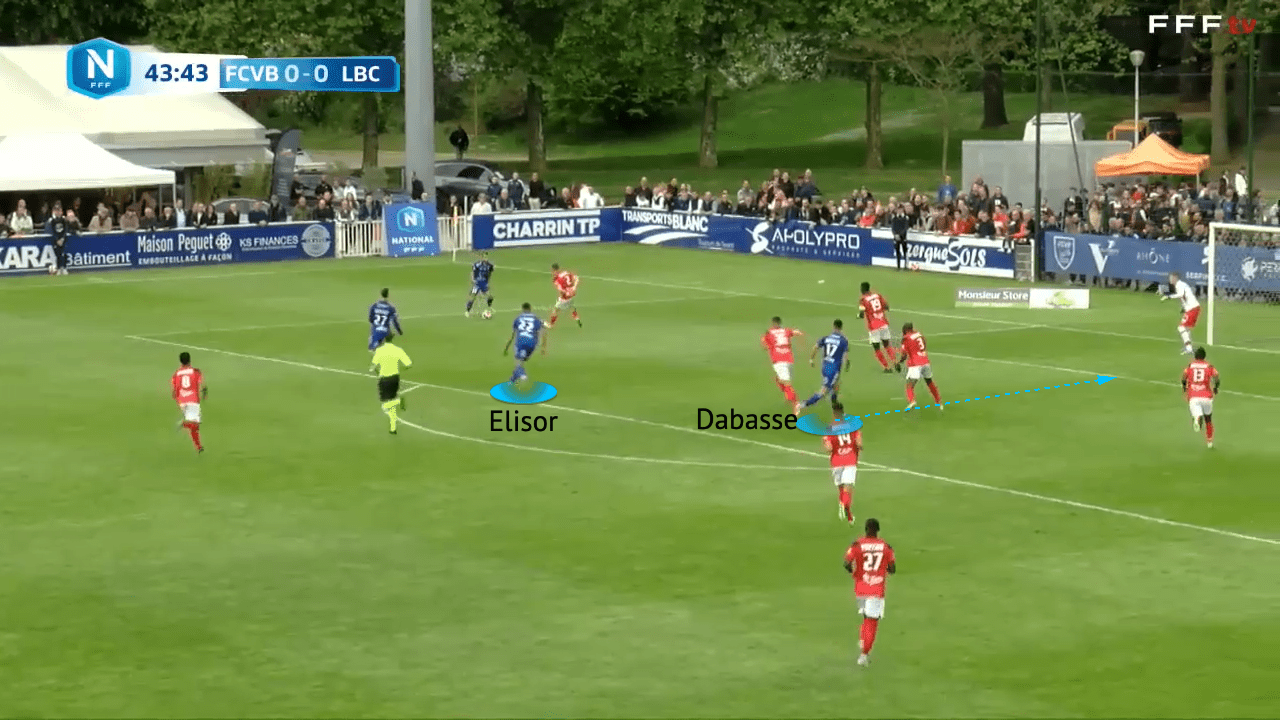
This figure shows Dabasse’s ability to get into the box to occupy dangerous positions after influencing progression in deeper areas, following on from the figure above. Dabasse carried the ball infield and spread the play out wide to the left. Immediately after executing the pass, Dabasse travelled into the penalty box to potentially receive a return pass. He sees his strike partner Simon Elisor drop away from his marker to create separation for a shot, so Dabasse makes an opposing movement with a burst towards the six-yard box. Elisor did not manage to get a shot on goal after a poor pass by Khous, but Dabasse’s movement towards the goal would have created the possibility of diverting an Elisor shot on goal or scoring a rebound from a goalkeeper parry.
Another strength of Villefranche Beaujolais is their tactical versatility, changing their shape to produce positive results. Their most common tactical switch is diverting from the 3-5-2 formation into a 4-4-2 with a diamond midfield. This switch increases the attacking influence of Guillaume Khous, moving into the attacking midfield position at the tip of the diamond from his original left wing-back position. Khous is now able to provide an option between the lines, a rarity in their starting 3-5-2, enabling Dabasse to prioritise perturbing opposition defences with Elisor.
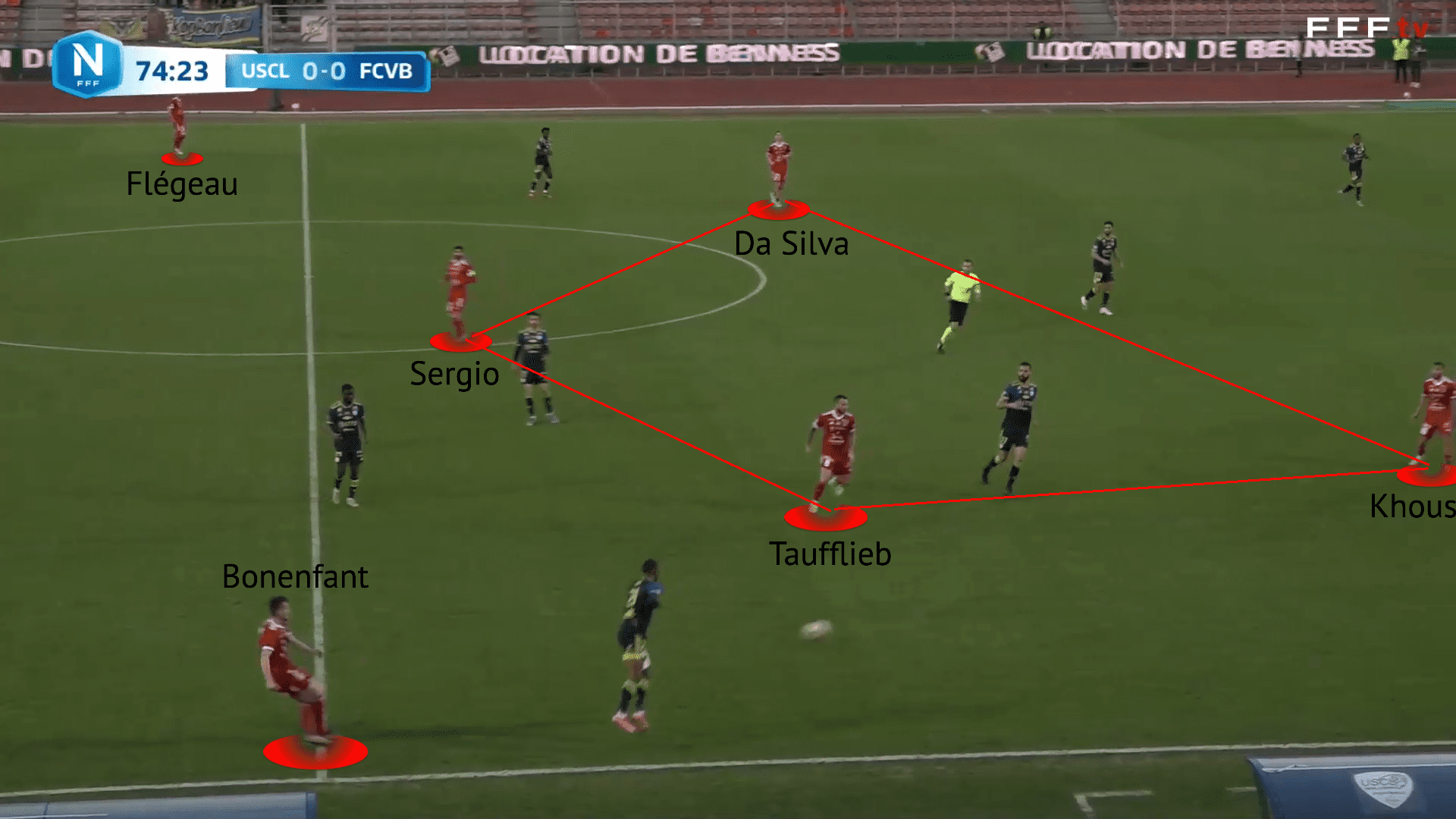
This figure shows the change in shape of the midfield diamond, with Khous at the tip and Rémi Sergio at the base, like the captain usually is in a midfield three. To allow Khous to move into this midfield role, Hervé Della Maggiore shifts left-sided centre back Nicolas Flégeau to left-back in the back four. The back-four change slightly restricts Rémi Bonenfant’s final third influence, but he still has license to advance and provide width.
At times, Villefranche Beaujolais have switched to a 4-2-2-2 with Da Silva and Khous operating behind the Elisor and Dabasse strikeforce. Villefranche Beaujolais’ seamless transitions into different shapes to inspire a change in performance is an extremely effective strength. With Dabasse and Elisor taking the third and fifth-most shots in the Championnat National this season, Villefranche Beaujolais are able to find their threats in dangerous areas, regardless of what tactic Hervé Della Maggiore employs. The quality in midfield helps to ensure this too, with Taufflieb, Khous, and Sergio ranking in the top fifteen for deep completions per 90 whilst Florent Da Silva tops the chart with 2.13.
Weaknesses
Despite ranking well in the Championnat National for most attacking corner metrics, Villefranche Beaujolais have recently found defending corners to be a weakness. As stated above, the opposition’s ability to win a near-post flick-on has created goal-scoring opportunities against Villefranche Beaujolais at the back post, which also links other issues relating to slow reactions. Slow reactions are the biggest factor in Villefranche Beaujolais’ defensive corners struggles and are prevalent in short and direct corners, and second phases.
Principally, Villefranche Beaujolais defend short corners 2-vs-2, but slow reactions to short corner situations lead to the opposition combining and creating crossing opportunities 2-vs-1. Initially, Villefranche Beaujolais’ reaction to their defensive clearance is adequate, moving their defensive line up to the edge of the box at speed. The problem that arises is their slowness to pick up onside opposition players, leaving them free and the potential to be overloaded.
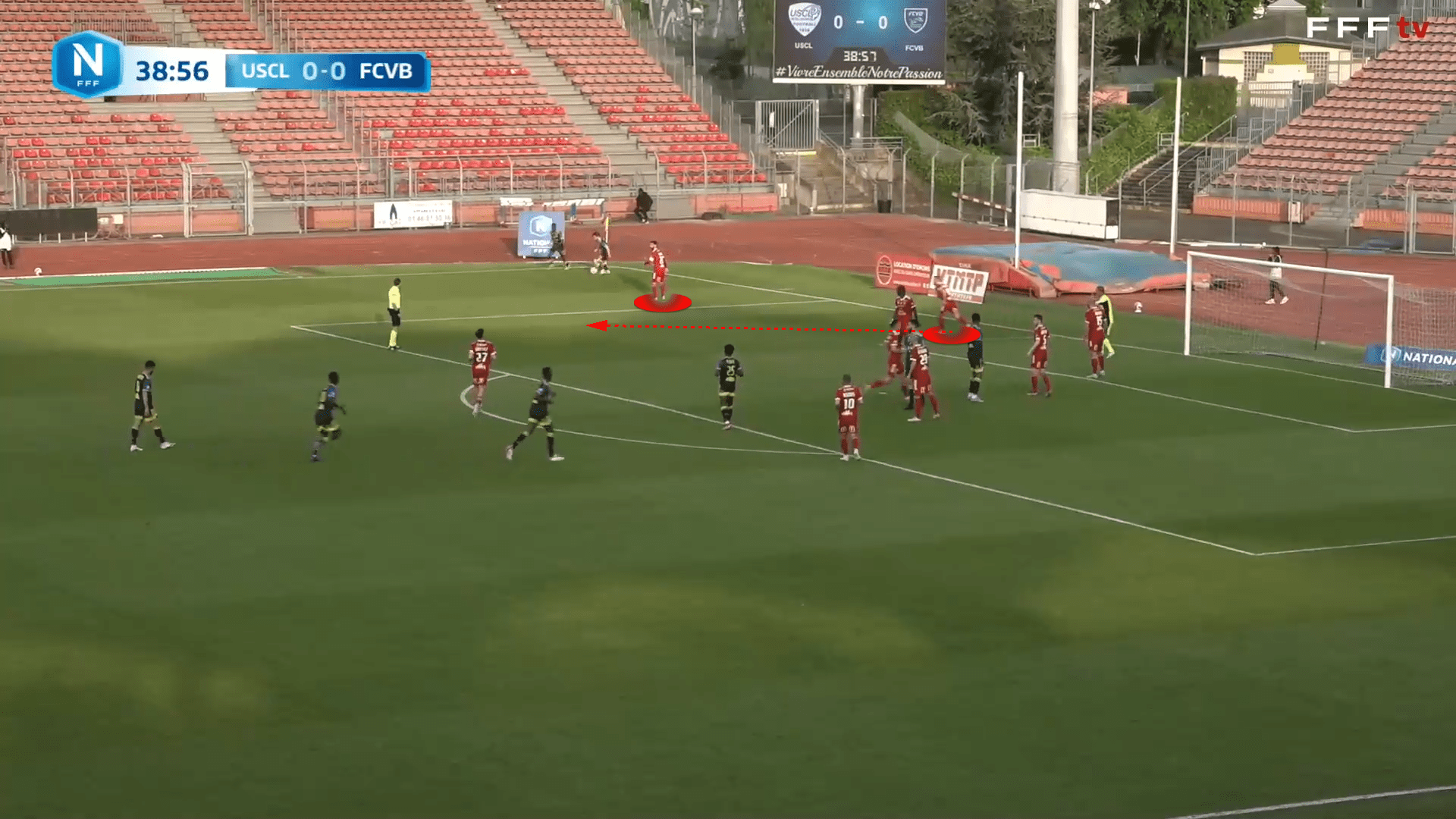
This figure shows lackadaisical defending of a short corner from Villefranche Beaujolais, allowing Creteil to execute a short corner. The slow and late reaction from the supporting defending player means Creteil were able to whip a cross towards the back post under no pressure.
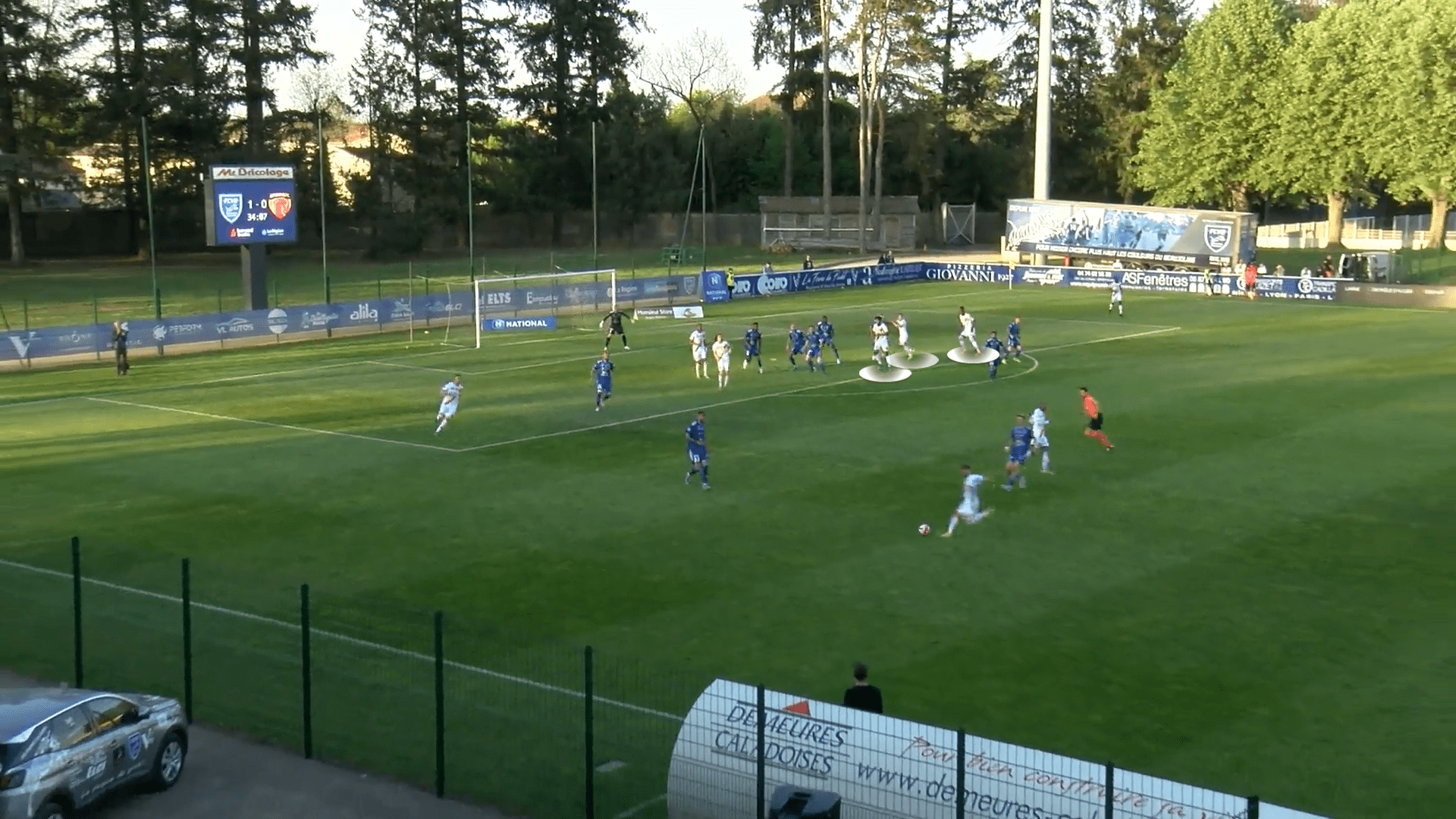
This figure is an example of Villefranche Beaujolais’ weakness from the second phase of defending opposition set-pieces. Here, Le Mans have an overload towards the back post, leading to a shot that went over the bar.
Another weakness of Villefranche Beaujolais is the large space they can allow between the lines of the midfield and defence. With their tendency of advancing the midfield line and giving the defensive line man-marking responsibilities, Villefranche Beaujolais give the opposition the chance to restrict the defensive line and enlarge space between the lines. As shown in the out of possession analysis, this space can really threaten Hervé Della Maggiore’s side and subsequently create goal-scoring opportunities.
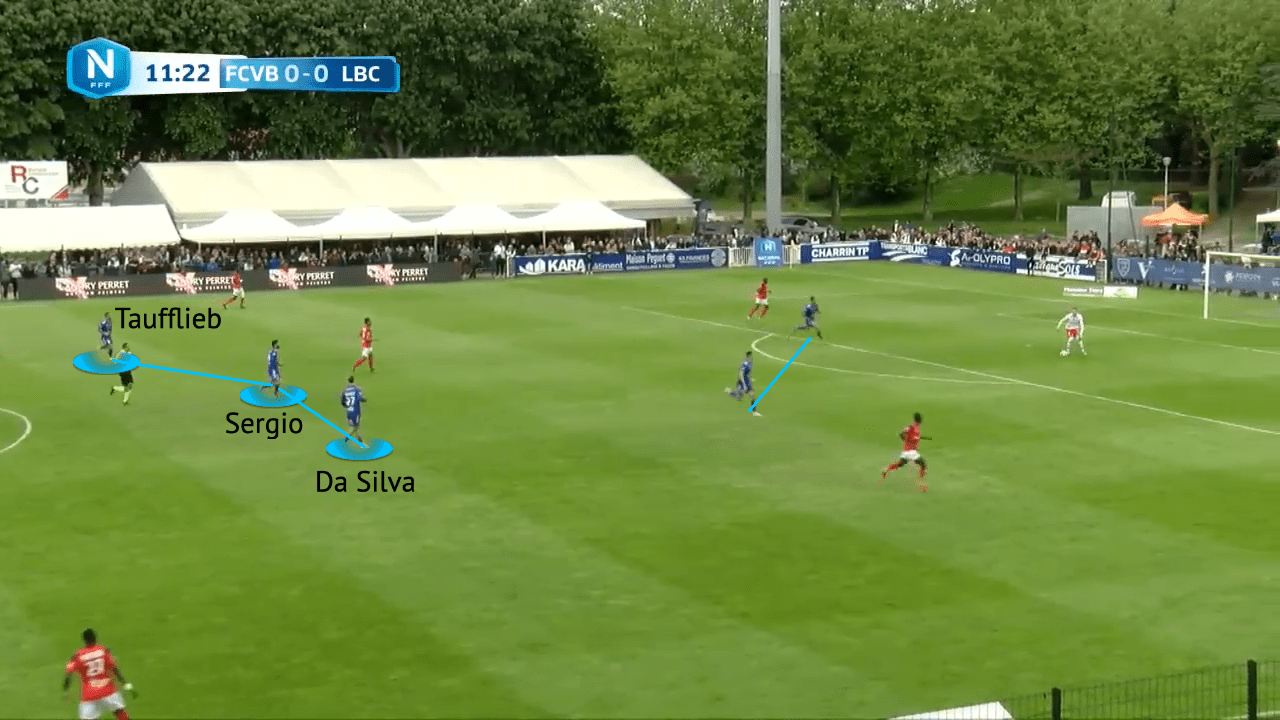
This example shows the Villefranche Beaujolais midfield on the same horizontal line, further expanding the space between the lines. A clipped pass over the midfield from the goalkeeper would find Chateauroux’s two central midfielders in space to turn. However, the goalkeeper decides to play a longer pass towards a striker.
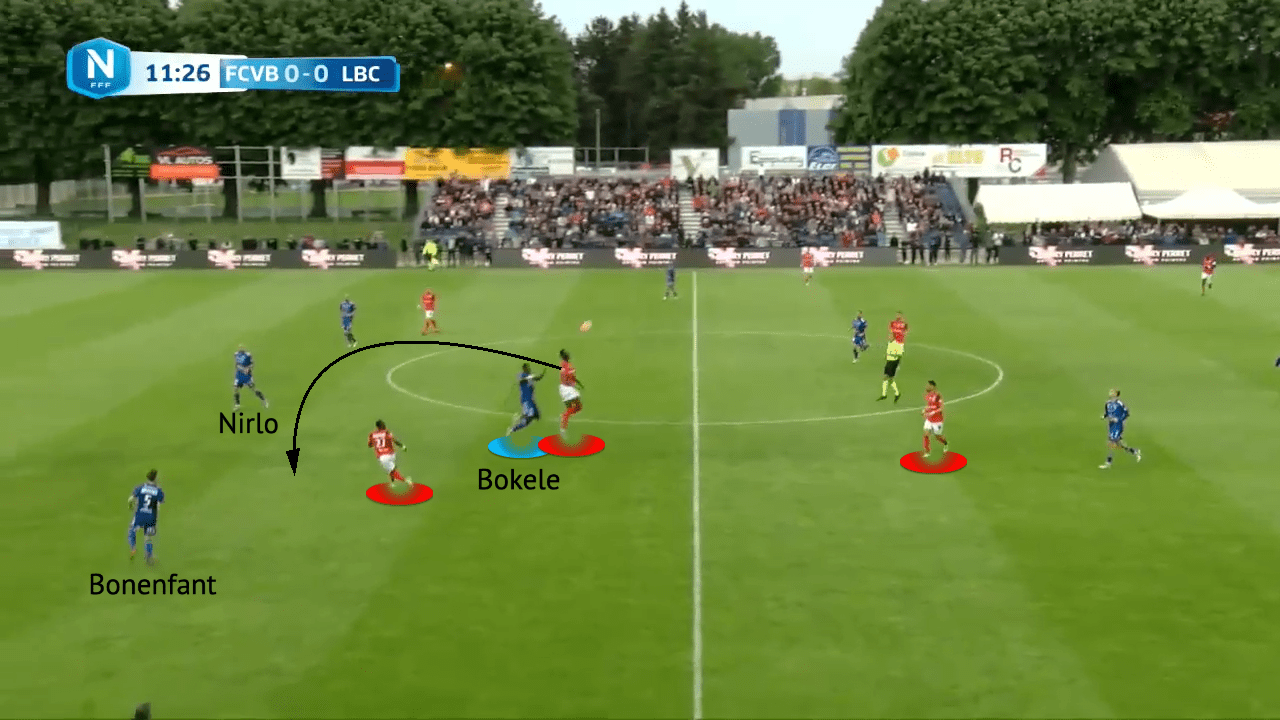
With the Chateauroux goalkeeper playing a more lofted and longer pass, man-marking centre back Malcom Bokele has to engage in an aerial duel with the Chateauroux striker. With Chateauroux matching Villefranche Beaujolais’ 3-5-2 formation, Bokele is responsible to man-mark one of Chateauroux’s strikers and Flégeau picks up the other striker. This leaves central centre back Jimmy Nirlo to provide cover. Bokele loses his aerial duel, meaning the Chateauroux left wing-back can control the flick on inside of Bonenfant and find the right-sided striker.
Conclusion
Ending the Championnat National season three points off being champions and two points off automatic promotion, Villefranche Beaujolais can gain promotion into Ligue 2 by overcoming Quevilly in the playoffs. This team analysis and scout report has discussed tactics that have influenced Hervé Della Maggiore’s team in their quest for promotion, leading to a third-place finish in the Championnat National. Defending set-pieces was identified as a weakness for Villefranche Beaujolais, but this is unlikely to be exploited by Quevilly, who have only scored one goal from a corner in Ligue 2 this season. However, the weakness regarding space between the lines could be exploited by Quevilly, with their most-used formation this season being a 4-2-3-1 with three players potentially occupying this space.

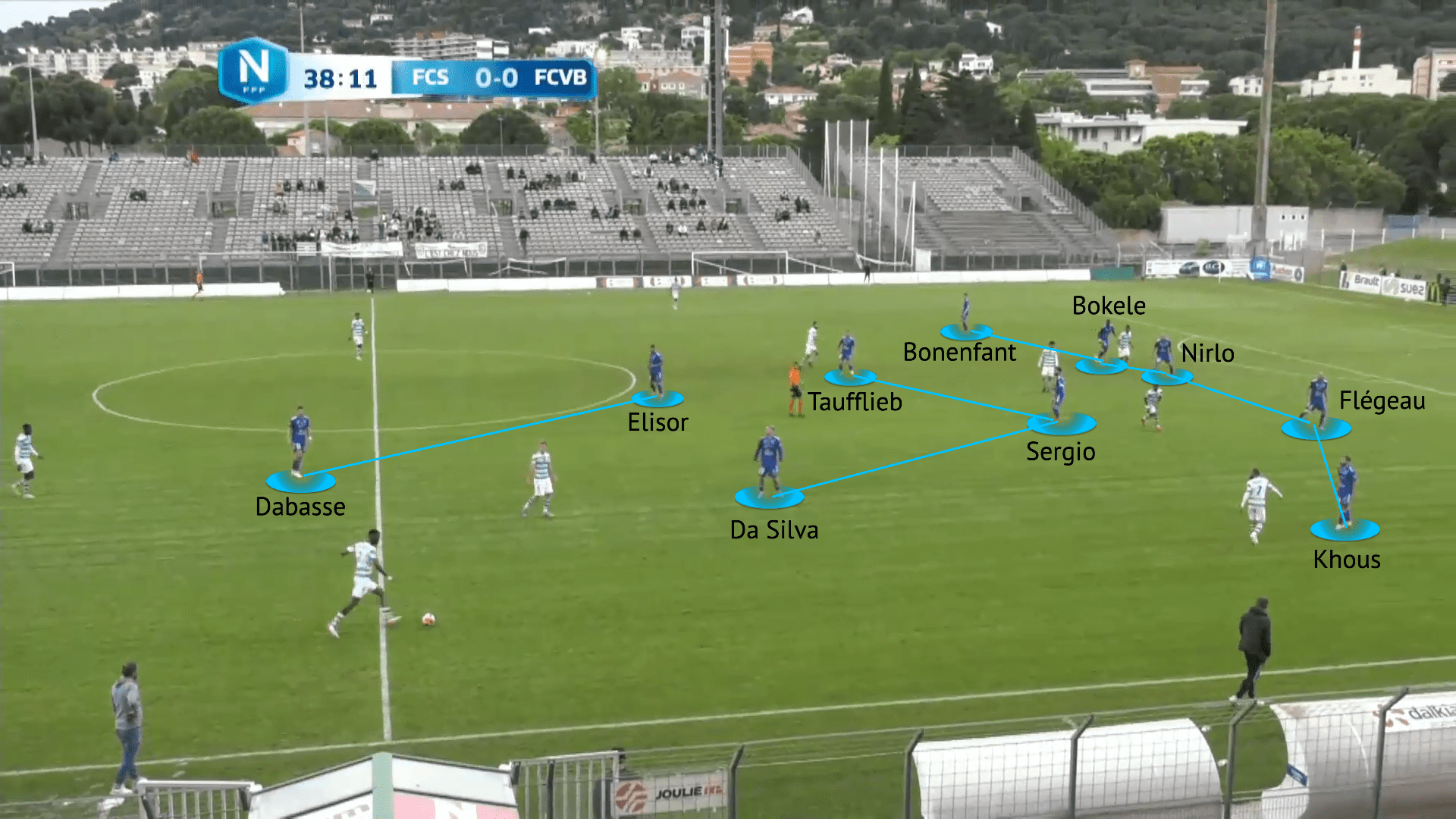



Comments